

Eight Disciplines of Problem Solving (8D)
– Eight Disciplines of Problem Solving –
⇓ Introduction to 8D
⇓ What is 8D
⇓ Why Apply 8D
⇓ When to Apply 8D
⇓ How to Apply 8D

Introduction to Eight Disciplines of Problem Solving (8D)
The Eight Disciplines of Problem Solving (8D) is a problem solving methodology designed to find the root cause of a problem, devise a short-term fix and implement a long-term solution to prevent recurring problems. When it’s clear that your product is defective or isn’t satisfying your customers, an 8D is an excellent first step to improving Quality and Reliability.
Ford Motor Company developed this problem solving methodology, then known as Team Oriented Problem Solving (TOPS), in the 1980s. The early usage of 8D proved so effective that it was adopted by Ford as the primary method of documenting problem solving efforts, and the company continues to use 8D today.
8D has become very popular among manufacturers because it is effective and reasonably easy to teach. Below you’ll find the benefits of an 8D, when it is appropriate to perform and how it is performed.
What is Eight Disciplines of Problem Solving (8D)
The 8D problem solving process is a detailed, team oriented approach to solving critical problems in the production process. The goals of this method are to find the root cause of a problem, develop containment actions to protect customers and take corrective action to prevent similar problems in the future.
The strength of the 8D process lies in its structure, discipline and methodology. 8D uses a composite methodology, utilizing best practices from various existing approaches. It is a problem solving method that drives systemic change, improving an entire process in order to avoid not only the problem at hand but also other issues that may stem from a systemic failure.
8D has grown to be one of the most popular problem solving methodologies used for Manufacturing, Assembly and Services around the globe. Read on to learn about the reasons why the Eight Disciplines of Problem Solving may be a good fit for your company.
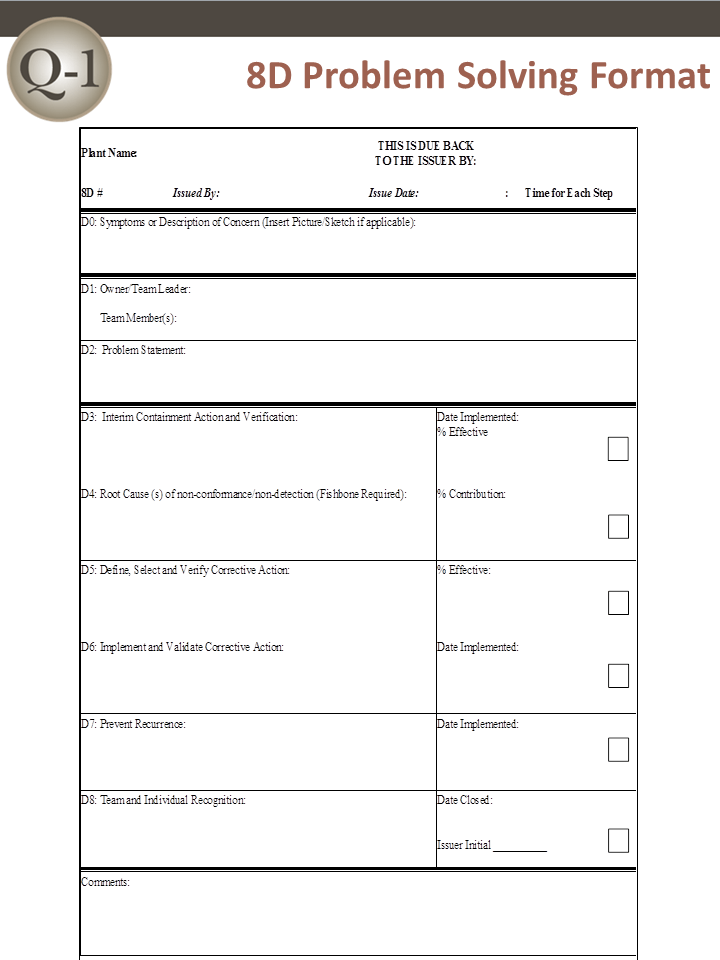
Why Apply Eight Disciplines of Problem Solving (8D)
The 8D methodology is so popular in part because it offers your engineering team a consistent, easy-to-learn and thorough approach to solving whatever problems might arise at various stages in your production process. When properly applied, you can expect the following benefits:
- Improved team oriented problem solving skills rather than reliance on the individual
- Increased familiarity with a structure for problem solving
- Creation and expansion of a database of past failures and lessons learned to prevent problems in the future
- Better understanding of how to use basic statistical tools required for problem solving
- Improved effectiveness and efficiency at problem solving
- A practical understanding of Root Cause Analysis (RCA)
- Problem solving effort may be adopted into the processes and methods of the organization
- Improved skills for implementing corrective action
- Better ability to identify necessary systemic changes and subsequent inputs for change
- More candid and open communication in problem solving discussion, increasing effectiveness
- An improvement in management’s understanding of problems and problem resolution
8D was created to represent the best practices in problem solving. When performed correctly, this methodology not only improves the Quality and Reliability of your products but also prepares your engineering team for future problems.
When to Apply Eight Disciplines of Problem Solving (8D)
The 8D problem solving process is typically required when:
- Safety or Regulatory issues has been discovered
- Customer complaints are received
- Warranty Concerns have indicated greater-than-expected failure rates
- Internal rejects, waste, scrap, poor performance or test failures are present at unacceptable levels
How to Apply Eight Disciplines of Problem Solving (8D)
The 8D process alternates inductive and deductive problem solving tools to relentlessly move forward toward a solution. The Quality-One approach uses a core team of three individuals for inductive activities with data driven tools and then a larger Subject Matter Expert (SME) group for the deductive activities through brainstorming, data-gathering and experimentation.
D0: Prepare and Plan for the 8D
Proper planning will always translate to a better start. Thus, before 8D analysis begins, it is always a good idea to ask an expert first for their impressions. After receiving feedback, the following criterion should be applied prior to forming a team:
Collect information on the symptoms
Use a Symptoms Checklist to ask the correct questions
Identify the need for an Emergency Response Action (ERA), which protects the customer from further exposure to the undesired symptoms
D1: Form a Team
A Cross Functional Team (CFT) is made up of members from many disciplines. Quality-One takes this principle one step further by having two levels of CFT:
- The Core Team Structure should involve three people on the respective subjects: product, process and data
- Additional Subject Matter Experts are brought in at various times to assist with brainstorming, data collection and analysis
Teams require proper preparation. Setting the ground rules is paramount. Implementation of disciplines like checklists, forms and techniques will ensure steady progress. 8D must always have two key members: a Leader and a Champion / Sponsor:
- The Leader is the person who knows the 8D process and can lead the team through it (although not always the most knowledgeable about the problem being studied)
- The Champion or Sponsor is the one person who can affect change by agreeing with the findings and can provide final approval on such changes
D2: Describe the Problem
The 8D method’s initial focus is to properly describe the problem utilizing the known data and placing it into specific categories for future comparisons. The “Is” data supports the facts whereas the “Is Not” data does not. As the “Is Not” data is collected, many possible reasons for failure are able to be eliminated. This approach utilizes the following tools:
- Problem Statement
- Affinity Diagram (Deductive tool)
- Fishbone/Ishikawa Diagram (Deductive tool)
- Problem Description
D3: Interim Containment Action
In the interim, before the permanent corrective action has been determined, an action to protect the customer can be taken. The Interim Containment Action (ICA) is temporary and is typically removed after the Permanent Correct Action (PCA) is taken.
- Verification of effectiveness of the ICA is always recommended to prevent any additional customer dissatisfaction calls
D4: Root Cause Analysis (RCA) and Escape Point
The root cause must be identified to take permanent action to eliminate it. The root cause definition requires that it can be turned on or off, at will. Activities in D4 include:
- Comparative Analysis listing differences and changes between “Is” and “Is Not”
- Development of Root Cause Theories based on remaining items
- Verification of the Root Cause through data collection
- Review Process Flow Diagram for location of the root cause
- Determine Escape Point, which is the closest point in the process where the root cause could have been found but was not
D5: Permanent Corrective Action (PCA)
The PCA is directed toward the root cause and removes / changes the conditions of the product or process that was responsible for the problem. Activities in D5 include:
- Establish the Acceptance Criteria which include Mandatory Requirements and Wants
- Perform a Risk Assessment / Failure Mode and Effects Analysis (FMEA) on the PCA choices
- Based on risk assessment, make a balanced choice for PCA
- Select control-point improvement for the Escape Point
- Verification of Effectiveness for both the PCA and the Escape Point are required
D6: Implement and Validate the Permanent Corrective Action
To successfully implement a permanent change, proper planning is essential. A project plan should encompass: communication, steps to complete, measurement of success and lessons learned. Activities in D6 include:
- Develop Project Plan for Implementation
- Communicate the plan to all stakeholders
- Validation of improvements using measurement
D7: Prevent Recurrence
D7 affords the opportunity to preserve and share the knowledge, preventing problems on similar products, processes, locations or families. Updating documents and procedures / work instructions are expected at this step to improve future use. Activities in D7 include:
- Review Similar Products and Processes for problem prevention
- Develop / Update Procedures and Work Instructions for Systems Prevention
- Capture Standard Work / Practice and reuse
- Assure FMEA updates have been completed
- Assure Control Plans have been updated
D8: Closure and Team Celebration
Teams require feedback to allow for satisfactory closure. Recognizing both team and individual efforts and allowing the team to see the previous and new state solidifies the value of the 8D process. Activities in D8 include:
- Archive the 8D Documents for future reference
- Document Lessons Learned on how to make problem solving better
- Before and After Comparison of issue
- Celebrate Successful Completion
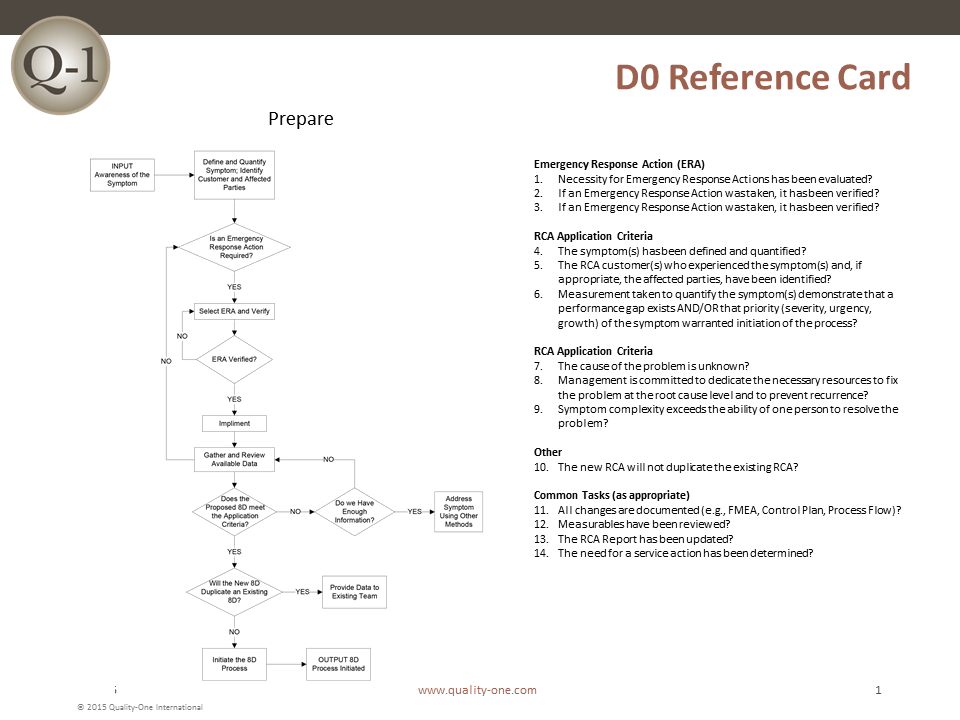
8D and Root Cause Analysis (RCA)
The 8D process has Root Cause Analysis (RCA) imbedded within it. All problem solving techniques include RCA within their structure. The steps and techniques within 8D which correspond to Root Cause Analysis are as follows:
- Problem Symptom is quantified and converted to “Object and Defect”
- Problem Symptom is converted to Problem Statement using Repeated Whys
- Possible and Potential Causes are collected using deductive tools (i.e. Fishbone or Affinity Diagram)
- Problem Statement is converted into Problem Description using Is / Is Not
- Problem Description reduces the number of items on the deductive tool (from step 3)
- Comparative Analysis between the Is and Is Not items (note changes and time)
- Root Cause theories are developed from remaining possible causes on deductive tool and coupled with changes from Is / Is Not
- Compare theories with current data and develop experiments for Root Cause Verification
- Test and confirm the Root Causes
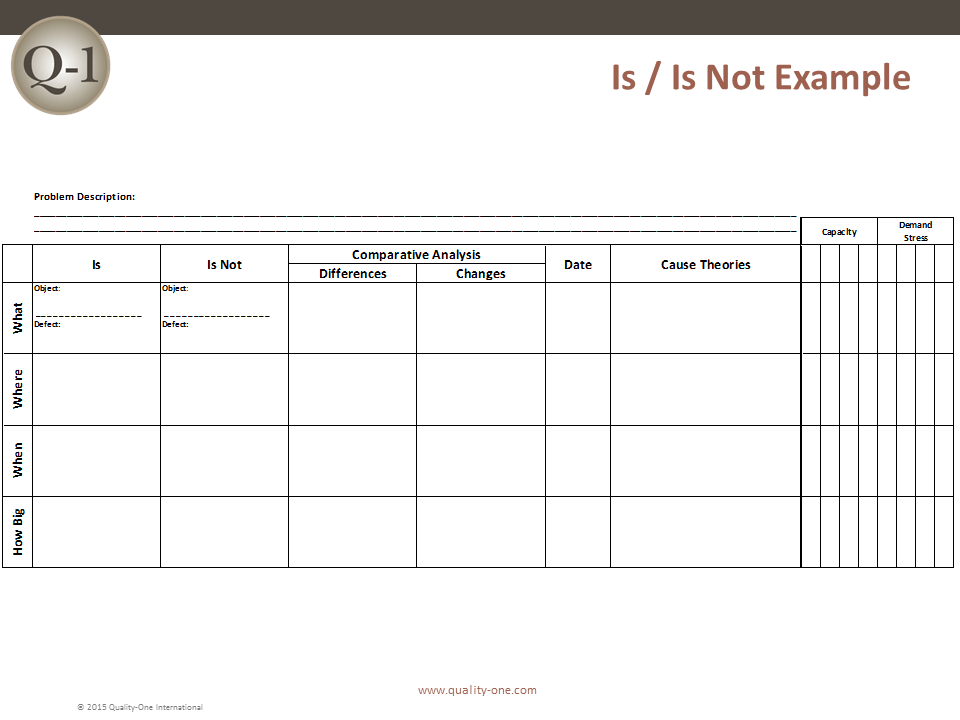
Example: Multiple Why Technique
The Multiple / Repeated Why (Similar to 5 Why) is an inductive tool, which means facts are required to proceed to a more detailed level. The steps required to determine problem statement are:
- Problem Symptom is defined as an Object and Defect i.e. “Passenger Injury”
- Why? In every case “SUV’s Roll Over”
- Why? In every case, it was preceded by a “Blown Tire”
- Why? Many explanations may be applied, therefore the team cannot continue with another repeated why past “Blown Tire”
- Therefore, the Problem Statement is “Blown Tire”
- Why? Low (Air) Pressure, Tire Defect (Degradation of an Interface) and High (Ambient) Temperature
- Counter measures assigned to low pressure and tire defect
This example uses only 4 of the 5 Whys to determine the root causes without going further into the systemic reasons that supported the failure. The Repeated Why is one way to depict this failure chain. Fault Tree Analysis (FTA) could also be used.
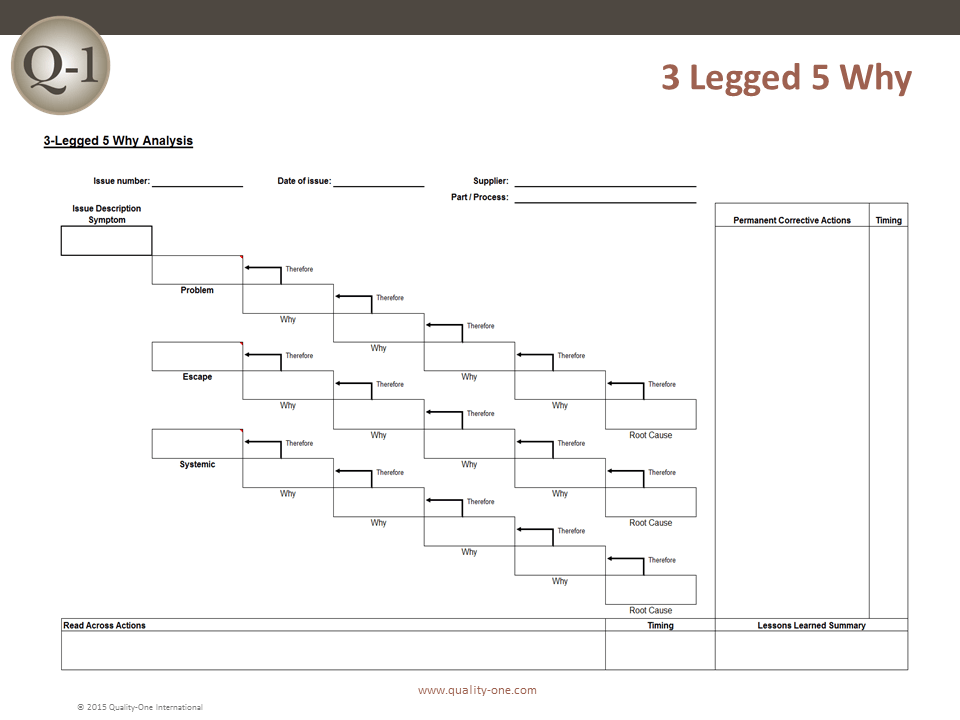
Learn More About Eight Disciplines of Problem Solving (8D)
Quality-One offers Quality and Reliability Support for Product and Process Development through Consulting, Training and Project Support. Quality-One provides Knowledge, Guidance and Direction in Quality and Reliability activities, tailored to your unique wants, needs and desires. Let us help you Discover the Value of 8D Consulting , 8D Training or 8D Project Support .
Contact Us | Discover the Value!
(248) 280-4800 | [email protected]
Remember Me
Advisory boards aren’t only for executives. Join the LogRocket Content Advisory Board today →

- Product Management
- Solve User-Reported Issues
- Find Issues Faster
- Optimize Conversion and Adoption
An overview of the 8D problem-solving method
The 8D problem-solving method is a powerful tool in product management. It’s designed to help product managers tackle issues systematically and enhance product quality. This method follows eight steps in total, hence the name 8D.
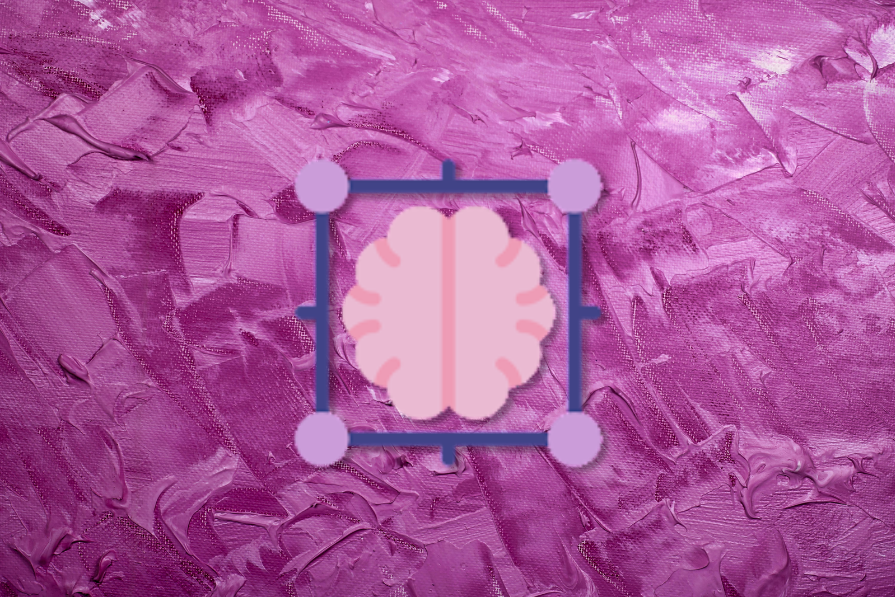
The steps range from identifying problems to implementing long-term solutions. Today you’ll explore how you can effectively apply 8D to your products. You’ll also learn about the benefits of using this approach and analyze some real case studies.
What is 8D?
The 8D problem-solving method is designed to address and resolve problems by identifying, correcting, and eliminating recurring issues.
It involves eight different steps:
- Plan — Prepare for the problem-solving process
- Team selection — Assemble a team with the necessary knowledge and skills
- Problem definition — Clearly define the problem and its impact
- Interim containment action — Implement temporary measures to contain the problem
- Root cause identification — Identify the underlying cause(s) of the problem
- Permanent corrective action — Develop and implement a solution to address the root cause
- Preventive measures — Take steps to prevent the recurrence of the problem
- Team recognition — Acknowledge and reward the team’s efforts in resolving the issue
These steps focus on root cause analysis, preventive measures, and long-term solution implementation. The end goal is to improve product quality and operational efficiency.
The eight disciplines of 8D
The eight disciplines of the 8D method represent a comprehensive approach to solve problems within an organization. Each discipline is designed to guide teams through the process at each stage. Here’s a deeper look into each stage:
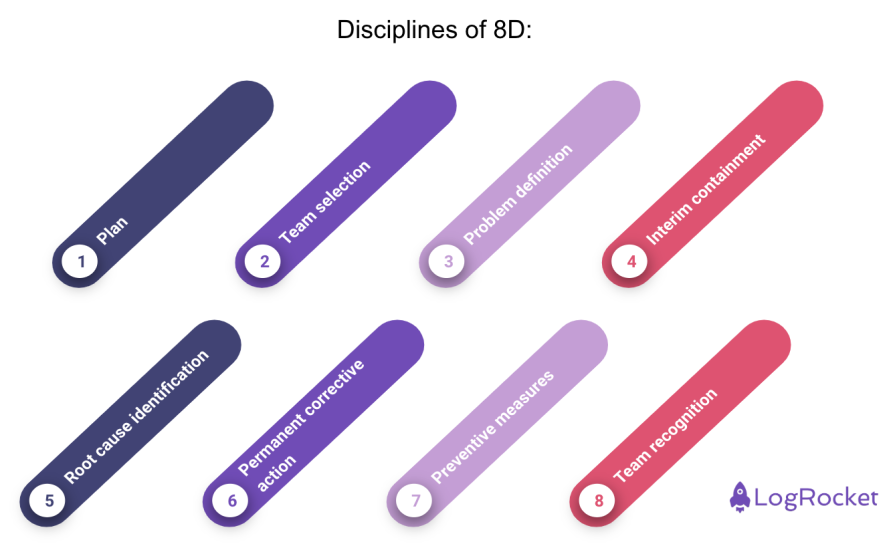
This initial step involves preparing for the problem-solving process. The goal here is to understand the problem’s magnitude and set up objectives. It’s about getting ready to tackle the issue systematically.
Team selection
In this step, a cross-functional team is formed. The team should consist of individuals with the necessary knowledge, skills, and experience to address the problem effectively. The team works together throughout the 8D process.
Problem definition
Next, the team has to describe the issue in specific terms. The goal here is to understand the impact and scope of the complication. A well-defined problem is easier to solve.
Interim containment
In the process of finding a solution, temporary measures are taken to contain the problem and prevent it from worsening. This reduces further damage or impact to the involved operations.
Root cause identification
In this phase, the team uses various tools and techniques to identify the underlying cause of the problem. An understanding of the root cause is essential for developing an effective, lasting solution.
Permanent corrective action
With the root cause identified, the team moves to develop a permanent corrective action plan to resolve the issue. Now, the team needs to choose the best solution, implement it, and monitor its effectiveness. This analysis will ensure that the problem is truly resolved.

Over 200k developers and product managers use LogRocket to create better digital experiences
Preventive measures
With such vast processes, there is always a possibility of the problem recurring. To resolve this, the team identifies and implements measures that address the root cause. There might be a need for changes to different aspects of the overall approach.
Team recognition
The final stage focuses on acknowledging and rewarding the team’s efforts. Recognizing the team’s hard work and success in resolving the issue is important for morale. It also promotes a culture of continuous improvement.
By following these eight disciplines, product managers can solve problems more effectively. The other benefit is that it builds a proactive culture that addresses issues before they escalate.
Applying 8D in product management
Applying the 8D problem-solving method in product management involves leveraging its structured approach. This helps you eliminate problems and process improvement initiatives.
Problem identification
The 8D process begins with gathering data and feedback to quickly identify potential issues. After that, a diverse team from various departments works together to uncover issues. And finally, the team solves the problems efficiently.
Once a problem is spotted, quick fixes are applied to limit its impact. Simultaneously, you explore root causes of an issue using methods like the Five Whys . The final step is to implement the solution based on these insights. Occasionally, redesigns or process upgrades are also used to resolve the issue thoroughly.
Elimination
To eliminate recurring problems, it’s crucial to establish preventive measures. Several steps support the main goal of elimination including process adjustments, quality control improvements, and updates to design standards.
The insights gathered from each 8D cycle help with continuous improvement. It also aids in formulating strategies to avert future issues.
Benefits of the 8D method
The main benefit of using the 8D method is its impact on teamwork and continuous improvement. The more obvious benefits focus on root cause analysis and prevention of issues:
- Enhanced quality control
- Efficient problem resolution
- Systematic and thorough approach
- Teamwork and knowledge sharing
- Focus on root cause analysis
- Reduced recurrence of issues
- Cost reduction
- Improved customer satisfaction
The systematic approach to address issues ensures that no effort goes to waste. Eventually, it helps the teams to quickly propose long-term solutions to a range of problem patterns.
Challenges in implementing 8D
The 8D problem-solving method is extremely valuable when used in the right manner. However, there can be challenges at every stage of this process. Because of this, it’s beneficial for you to have an understanding of how to quickly identify these challenges.
These include:
- Resistance to change among team members
- Insufficient teamwork and collaboration
- Lack of training on the 8D methodology
- Difficulties in data collection and analysis
How to solve them?
- Clearly communicate benefits to overcome resistance
- Foster collaboration and teamwork among participants
- Provide targeted training on the 8D process
- Encourage data analysis for effective problem-solving
For a deeper understanding, let’s take a look at two case studies of how the 8D process can enhance the product management workflow.
Real-life examples of 8D
A leading tech company, (similar to Apple) faced public backlash over smartphones overheating and reduced battery life. In this context, the 8D method helped to quickly identify and contain the issues.
The root cause analysis helped it track the problem back to a battery design flaw. Collaborative efforts with the battery supplier led to a redesigned battery and an update to the operating system. This not only resolved the issue but also restored consumer trust. Eventually, the brand’s reputation for quality was restored.
Similarly, a major automaker found a software glitch in its driver-assistance systems. This issue was risking driver safety. Using the 8D method, it pinpointed outdated algorithms as the root cause. The solution was simple, it issued a software update and enhanced its development processes.
Both of these examples are evidence of how the 8D method can be utilized to prevent complications efficiently.
Key takeaways
In wrapping up, it’s clear that this approach is more than just a procedure. Think of it as a strategic framework designed for the product manager. The 8D method equips you with a robust toolkit for addressing and preempting issues, systematically.
On top of that it helps you to:
- Promote teamwork and continuous improvement
- Reduce problem recurrence through root cause analysis
- Overcome implementation challenges with effective communication
Feel free to comment with any questions you may have!
Featured image source: IconScout
LogRocket generates product insights that lead to meaningful action
Get your teams on the same page — try LogRocket today.
Share this:
- Click to share on Twitter (Opens in new window)
- Click to share on Reddit (Opens in new window)
- Click to share on LinkedIn (Opens in new window)
- Click to share on Facebook (Opens in new window)
- #agile and scrum
- #project management

Stop guessing about your digital experience with LogRocket
Recent posts:.

A guide to product advertising
Product advertising involves you marketing a product or set of products instead of marketing the brand itself.

Leader Spotlight: Creating a ‘choose your own adventure’ experience, with Peter Sucher
Peter talks about how he works to enable Girl Scouts to express themselves and engage their customer base at the level they desire.

How “what if” analysis can improve your product management strategy
“What if” analysis helps product and tech teams create a plan that accounts for various hypothetical situations.

Leader Spotlight: The responsibility of building zero-to-one products, with Pratik Chawla
Pratik Chawla talks about prioritization when building zero-to-one products and the responsibility of building products for millions of users.
Leave a Reply Cancel reply

Designorate
Design thinking, innovation, user experience and healthcare design
What is the 8D Problem Solving? And How to use the 8D Report?
The 8D problem-solving process (also known as the 8 Disciplines) is very different from previous processes we explored previously, such as the Double Diamond process or the IBM Design Thinking. The 8D process works in a rigid standardised nature to address the crisis caused by problems. The 8D process aims to walk with the team to highlight the problem, its root causes and propose a long-term solution. The process is documented in an 8D report which includes details of each of the eight stages. At the end of this article, we will explore an example report, and you can find a free 8D report template to download.
In times of crisis, companies face the challenge of analysing and solving problems efficiently in a short time to save developed projects. Problem-solving techniques such as the TRIZ method and Hurson’s Production Thinking Model allow companies to overcome crises and solve problems using less effort and time.
- Stage Gate Process: The Complete Practice Guide
- The Double Diamond Design Thinking Process and How to Use it
- A Guide to the SCAMPER Technique for Creative Thinking
- Design Thinking Tools: Reverse Brainstorming
Brief History of the 8D Problem Solving
The 8D method was first implemented by the US government during WW II as a military standard and was referred to as the Army Directive 1520, “Remedies and disposal of nonconforming materials.” In 1987, the demand for a team-oriented problem-solving method increased among the management organisation in the automotive industry to find a way to eliminate recurring issues.
Ford Motor Company published their manual, Team Oriented Problem Solving (TOPS), which includes their 8 Disciplines of the problem-solving process. The process was initially used to deal with quality control and safety issues inside the company but later expanded its role to a team approach problem-solving method. The 8D process is employed by engineers and designers to identify, analyse, and correct problems by eliminating the primary source that caused the problem.
So, what are the eight steps in the 8D methodology? The 8D problem solving process includes 8 Disciplines. In the mid-90s, a D0 step for planning was added to the process. The 8D steps include the following:
- D1: Team formation
- D2: Describe the problem
- D3: Develop a temporary containment plan
- D4: Determine and verify root causes
- D5: Verify the permanent solution
- D6: Implement the permanent solution
- D7: Prevent recurrence
- D8: Congratulate your team
The 8 Disciplines aim to achieve the following targets while solving the specified problem:
- Think as a team while solving the problem
- Isolate the situation and understand its causes
- Identify the factors that contribute to the problem
- Provide a temporary solution to halt the impact of the problem
- Eliminate the causes of the problem and the factors contributing to it
- Prevent the problem from recurring
When Should the 8D Problem Solving be Used?
Based on the above targets, the 8D problem solving process is designed for complex problems whose solution exceeds the ability of one expert. Also, it aims to establish communication for problem resolution through different levels inside the company. In some situations, the consumer or the management team requests the application of the 8D process through several forms or documentation.
While 8D problem solving is suitable for recurring problems that may repeatedly occur within a project or company, it is not ideal for simple issues that can be solved quickly by individual efforts. The process is unsuitable for a problem that can be solved with a straightforward solution. The 8D process is designed for complex issues, which require several weeks to solve and the involvement of at least four people.
8D problem solving provides a systematic process to find and solve problems. Therefore, if the situation requires choosing between alternative solutions, 8D acknowledges that other tools may help solve the problem better than the 8D process.
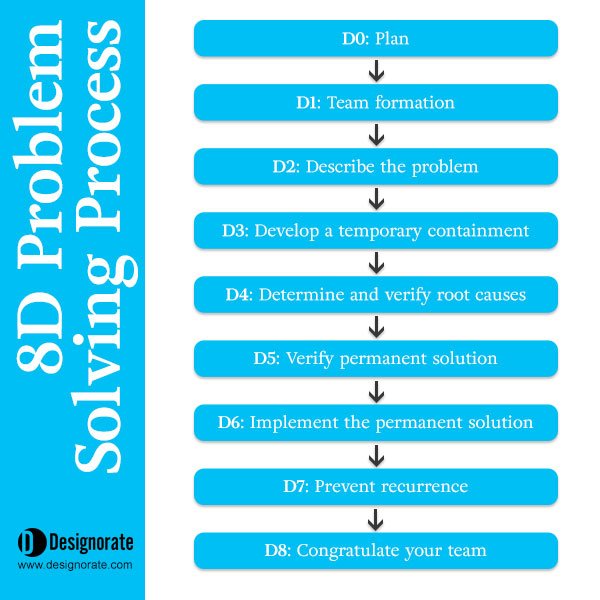
How to Apply the 8D Problem Solving Process?
The steps below form the 8 Discipline process to achieve targeted problem solving through the eight steps.
This discipline is also known as the Pre 8D because it aims to understand the problem and determine if the 8D process is the correct method to use. At this stage, the team aims to answer general questions such as:
- Is this a new problem, or has it happened before?
- Is this a recurring problem?
- What is the history of this issue?
- What was the method used to solve the problem before?
At this stage, the target is to learn about the problem’s history and decide if the 8D process is the best tool to solve the problem.
D1: Team Formation
Thinking as a team can produce more efficient solutions than trying to solve a problem alone. The team includes all the stakeholders involved in the situation. The team communicates with each other and performs brainstorming to solve the problem (check Design Thinking Tools: Reverse Brainstorming ). If the team does not know each other, the brainstorming time can be used to learn how to teach members to explore ideas together. Methods can be used in brainstorming sessions such as mind mapping , Six Thinking Hats , and Lego Serious Play.
D2: Describe the Problem
After team formation, the second step is to understand the problem and its risks. This stage starts with a risk analysis to identify the situation and how it can affect the project flow. Several methods can be used to analyse the problem from different perspectives, including SWOT analysis , SCAMPER technique , and similar tools. This stage is essential to building a clear vision of the problem and ensuring all stakeholders have the same understanding of the situation.
D3: Develop a Temporary Containment Plan
While solving the problem, there should be a temporary containment plan to prevent the problem from affecting the rest of the project or the final product. This temporary containment solution is a short-term operation such as adding more labour, increasing the quality measurements, applying a risk plan, etc.
It is essential to understand that the containment action is not the real solution and can only be used for the short term. Therefore, this action can be applied internally and not affect the process of reaching a permanent solution.
D4: Determine and Verify Root Causes
This stage aims to investigate the root causes of the problem; it can be considered the core of the 8D problem solving process. In many problems, what we see as causes are symptoms of other root causes. This misunderstanding can lead to inaccurate attempts at solutions that can have negative consequences in the future and leave the underlying problem unsolved.
An intensive investigation should be implemented because, in many cases, the root cause is hidden inside the process and covered by many symptoms, which is confusing. Some tools can be used to define the root causes of the problem, such as brainstorming , statistical analysis, flow charts, audits, etc.
D5: Verify the Permanent Solution
Once the root cause is defined, the solution becomes apparent, and the team better understands how to solve the problem. However, the symptoms and other related factors may create difficulties deciding how best to apply the solution. So, these other factors should be considered when determining the permanent solution to the dilemma.
When choosing the permanent solution to the problem, it should meet the following criteria to ensure it is the ideal solution for the problem:
- The solution should be practical
- The solution should be feasible
- The solution should be cost-effective
- The solution should not fail during production
- The solution should be implemented in all affected facilities in the company
D6: Implement the Permanent Solution
Once the solution is approved, this step tends to work as an action plan. This plan aims to outline the steps to implement the solution. It is common to ask questions in this stage: What should be done? Who should be involved in the correction plan?
More documentation and detailed plans should be created if the solution is complex and needs further procedures. The method may include training the team and checking the plan’s progress for further development and improvement.
D7: Prevent Recurrence
Once the action plan is set and ready to be implemented, the team should establish a plan to prevent the problem from occurring in the future. The action plan should be tested and documented as part of the process to avoid the recurrence of the problem. Some of the tools that can achieve this goal are Control Charts, Capabilities Analysis, and Control Plans.
D8: Congratulate the Team
After completing the task and implementing the solution, the team deserves an acknowledgement of their work and a celebration. This event will positively impact the stakeholders and reflect recognition of employees’ efforts from the management inside the company.
How do you Write an 8D Report?
The primary documentation used in the problem solving process is the 8D report. Korenko et al. (2013) presented an example of the 8D problem-solving application, Application 8D Method For Problems Solving . After this example, you can find a free 8D Report template that you can download and use for both commercial and noncommercial applications. The first part of the report, D0, includes information about the problem and the project details related to the project. D1 section contains details of the team involved in the project, roles, titles and contact information. D2 part of the report includes a detailed description of the problem and possible visual images to show the problem clearly. The report can consist of the type of damage of the failure and the function where the problem occurs (Figure 2).
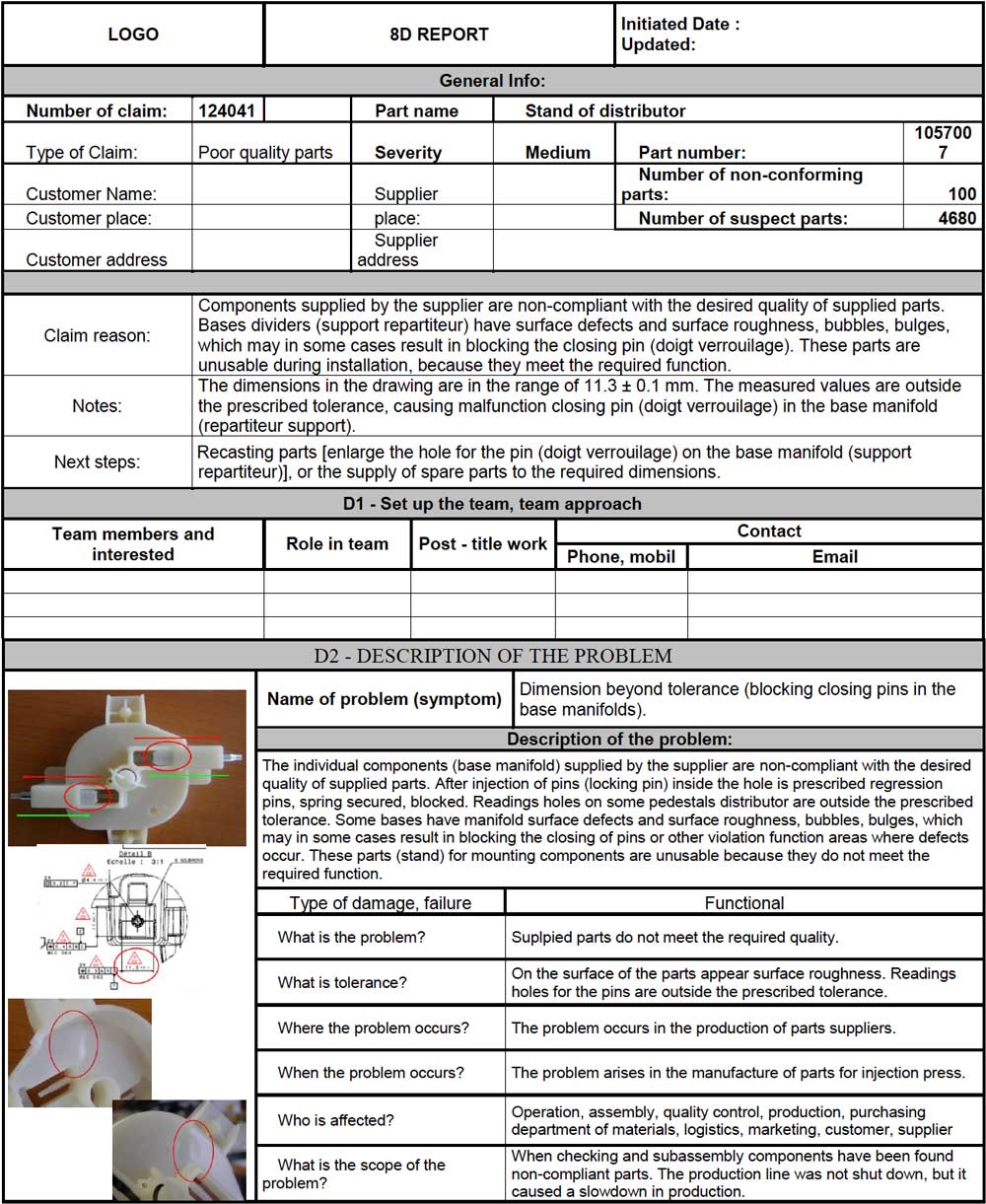
D3 includes details of the temporary solution for the problem required to stop the damage rapidly. In this part, the temporary remedy is described, particularly the symptoms affect, the responsibility, and the validation of the action. In D4, the team uses a root-cause method such as the 5WHYs or the Cause-Effect analysis (Fish Bone method). These methods help the team to identify the root causes of the problem. In Figure 3, the 5WHYs method is used several times to identify the root cause of the problem.
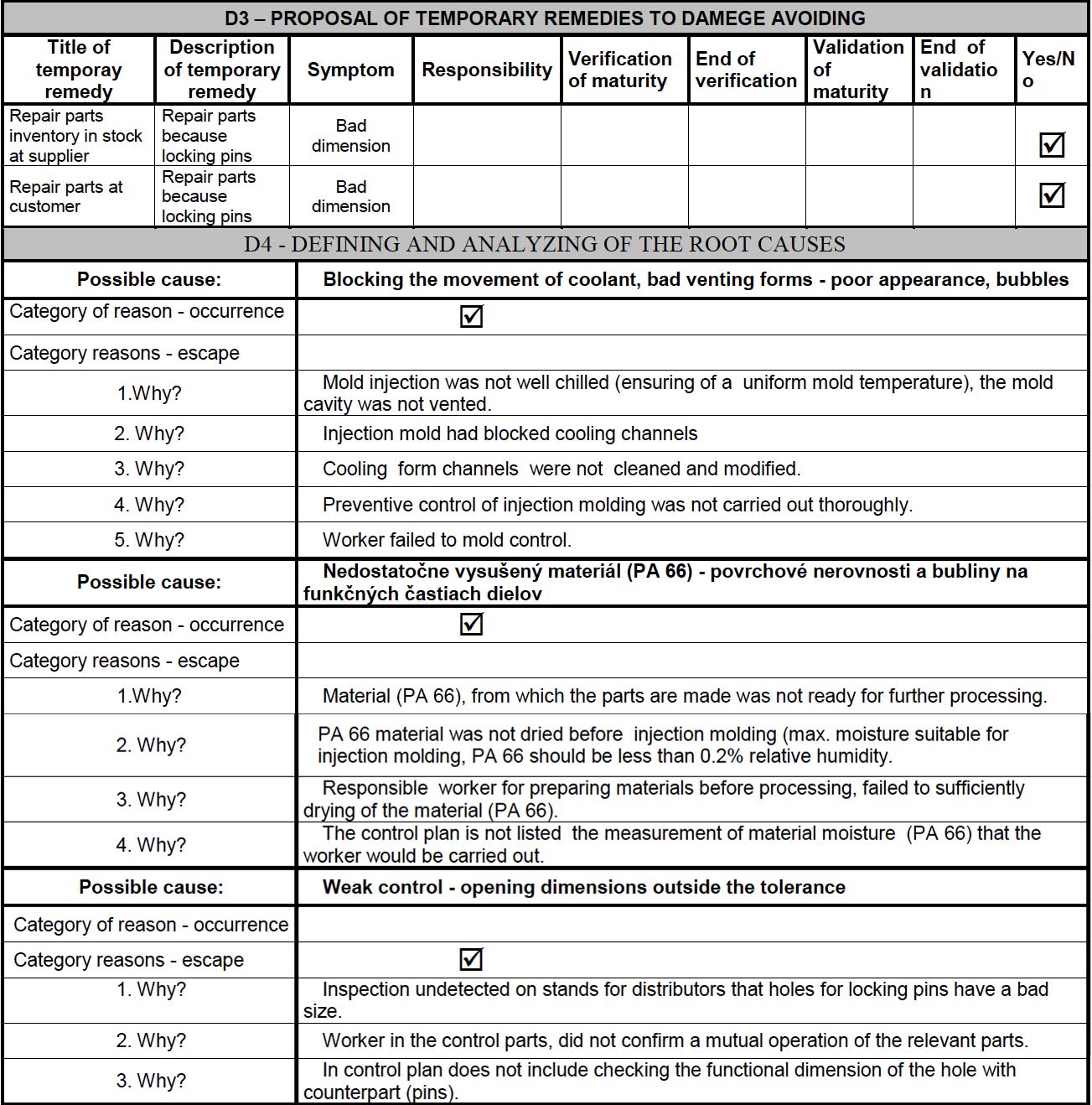
D5 of the report provides details about the permanent solution to fix the problem. Unlike the temporary solution, this aims to element the root causes of the problem. This section includes the procedure’s name, the reason to use it, the responsibility, the management approval to apply it and the expected date of completing the utilisation of the solution, as seen in Figure 4. In the following stage, D6, the team provides details on the implementation and validation of the permanent action.
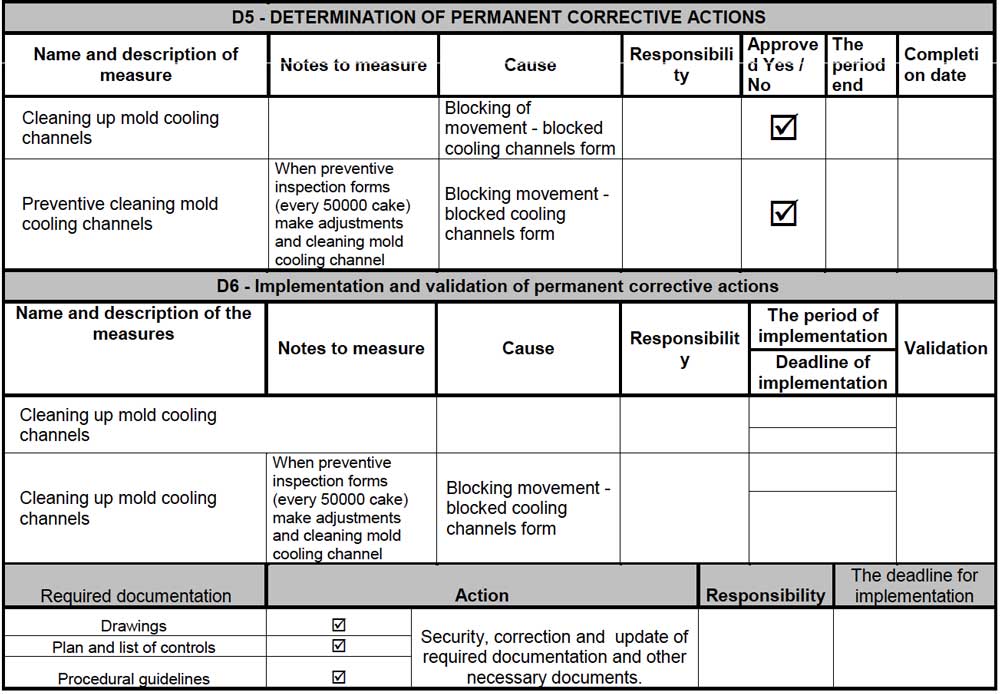
D7 provides details about preventing the recurrent problem, such as the name of the action after the validation process in the previous stage. Also, this stage provides details of the cause behind this action and elements about its responsibility and implementing details. Finally, in D8, the report includes a summary of the procedure and the proper approvals related to the procedure implementation (Figure 5).
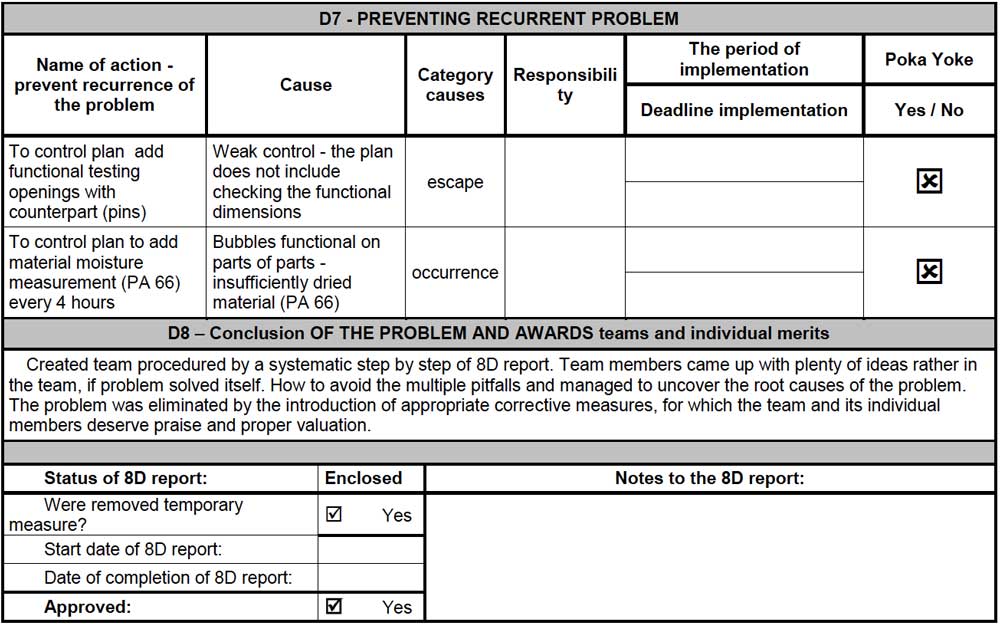
Free 8D Report Template Download

You can download the below 8D report, which you can use for commercial and noncommercial projects. Don’t forget to mention Designorate as the source of this free 8D report.
The 8D Problem Solving process provides a reliable and systematic method that ensures that the problems inside a company or project are solved by eliminating their root causes and preventing recurrence. However, it is most suitable for complex problems that can take weeks or even months to solve. Therefore, the first stage aims to determine if the 8D process is ideal for the problem or if more straightforward tools should be implemented. If the 8D problem solving method is appropriate for your business problem, you have a step-by-step template to guide you through your attempts to find a suitable solution to the obstacle you need to overcome.
Wait, Join my Newsletters!
As always, I try to come to you with design ideas, tips, and tools for design and creative thinking. Subscribe to my newsletters to receive new updated design tools and tips!
Dr Rafiq Elmansy
As an academic and author, I've had the privilege of shaping the design landscape. I teach design at the University of Leeds and am the Programme Leader for the MA Design, focusing on design thinking, design for health, and behavioural design. I've developed and taught several innovative programmes at Wrexham Glyndwr University, Northumbria University, and The American University in Cairo. I'm also a published book author and the proud founder of Designorate.com, a platform that has been instrumental in fostering design innovation. My expertise in design has been recognised by prestigious organizations. I'm a fellow of the Higher Education Academy (HEA), the Design Research Society (FDRS), and an Adobe Education Leader. Over the course of 20 years, I've had the privilege of working with esteemed clients such as the UN, World Bank, Adobe, and Schneider, contributing to their design strategies. For more than 12 years, I collaborated closely with the Adobe team, playing a key role in the development of many Adobe applications.
You May Also Like

10 Success Factors for the Experience Design Process

What is the Failure Mode and Effects (FMEA)?

Design Schools Should Teach Systems Thinking and This is Why

Designorate Mind Map Template
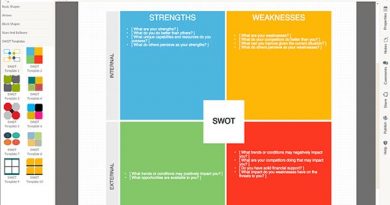
Six SWOT Analysis Tools and Applications

How Does Apple’s Design Process Work?
Leave a reply cancel reply.
Your email address will not be published. Required fields are marked *
Sign me up for the newsletter!
- Product overview
- All features
- Latest feature release
- App integrations
CAPABILITIES
- project icon Project management
- Project views
- Custom fields
- Status updates
- goal icon Goals and reporting
- Reporting dashboards
- workflow icon Workflows and automation
- portfolio icon Resource management
- Capacity planning
- Time tracking
- my-task icon Admin and security
- Admin console
- asana-intelligence icon Asana AI
- list icon Personal
- premium icon Starter
- briefcase icon Advanced
- Goal management
- Organizational planning
- Campaign management
- Creative production
- Content calendars
- Marketing strategic planning
- Resource planning
- Project intake
- Product launches
- Employee onboarding
- View all uses arrow-right icon
- Project plans
- Team goals & objectives
- Team continuity
- Meeting agenda
- View all templates arrow-right icon
- Work management resources Discover best practices, watch webinars, get insights
- Customer stories See how the world's best organizations drive work innovation with Asana
- Help Center Get lots of tips, tricks, and advice to get the most from Asana
- Asana Academy Sign up for interactive courses and webinars to learn Asana
- Developers Learn more about building apps on the Asana platform
- Community programs Connect with and learn from Asana customers around the world
- Events Find out about upcoming events near you
- Partners Learn more about our partner programs
- Support Need help? Contact the Asana support team
- Asana for nonprofits Get more information on our nonprofit discount program, and apply.
Featured Reads

- Project management |
- What is 8D? A template for efficient pr ...
What is 8D? A template for efficient problem-solving
How you respond when problems arise is one of the most defining qualities of a manager. Luckily, there are tools you can use to master problem-solving. The 8D method of problem-solving combines teamwork and basic statistics to help you reach a logical solution and prevent new issues from arising.
You’ve spent months overseeing the development of your company's newest project. From initiation, planning, and execution, you’re confident this may be your best work yet.
Until the feedback starts rolling in.
There’s no sugar-coating it—things don’t always go as planned. But production or process issues are hardly a signal to throw in the towel. Instead, focus on honing your problem-solving skills to find a solution that keeps it from happening again.
The 8D method of problem solving emphasizes the importance of teamwork to not only solve your process woes but prevent new ones from occurring. In this guide, we’ll break down what 8D is, how to use this methodology, and the benefits it can give to you and your team. Plus, get an 8D template to make solving your issue easier.
What is 8D?
The eight disciplines (8D) method is a problem-solving approach that identifies, corrects, and eliminates recurring problems. By determining the root causes of a problem, managers can use this method to establish a permanent corrective action and prevent recurring issues.
How do you use the 8D method?
The 8D method is a proven strategy for avoiding long-term damage from recurring problems. If you’re noticing issues in your workflow or processes, then it’s a good time to give this problem-solving method a try.
To complete an 8D analysis, follow “the eight disciplines” to construct a statistical analysis of the problem and determine the best solution.
The eight disciplines of problem-solving
8D stands for the eight disciplines you will use to establish an 8D report. As you may notice, this outline starts with zero, which makes nine total disciplines. The “zero stage” was developed later as an initial planning stage.
To illustrate these steps, imagine your organization experienced a decline in team innovation and productivity this past year. Your stakeholders have noticed and want to see changes implemented within the next six months. Below, we’ll use the 8D process to uncover a morale-boosting solution.
![what is the 8d problem solving method [inline illustration] D8 problem solving approach (infographic)](https://assets.asana.biz/transform/6ab7c188-3258-4d2e-afe6-9a4a084cc09f/inline-productivity-8d-template-1-2x?io=transform:fill,width:2560&format=webp)
D0: Prepare and plan
Before starting the problem-solving process, evaluate the problem you want to solve. Understanding the background of the problem will help you identify the root cause in later steps.
Collect information about how the problem has affected a process or product and what the most severe consequences may be. Planning can include:
Gathering data
Determining the prerequisites for solving the problem
Collecting feedback from others involved
![what is the 8d problem solving method [inline illustration] D0 Planning (example)](https://assets.asana.biz/transform/abc3621d-e1ae-47ff-b731-0ee38cff99e9/inline-productivity-8d-template-2-2x?io=transform:fill,width:2560&format=webp)
If we look back at our example, you may want to figure out whether this decline in morale is organization-wide or only applies to a few departments. Consider interviewing a few employees from different departments and levels of management to gain some perspective. Next, determine what knowledge and skills you will need to solve this lapse in productivity.
D1: Form your team
Create a cross-functional team made up of people who have knowledge of the various products and workflows involved. These team members should have the skills needed to solve the problem and put corrective actions in place.
Steps in this discipline may include:
Appointing a team leader
Developing and implementing team guidelines
Determining team goals and priorities
Assigning individual roles
Arranging team-building activities
![what is the 8d problem solving method [inline illustration] D1 Team members (example)](https://assets.asana.biz/transform/51986017-5150-4dd4-940c-252cd0eb8ba5/inline-productivity-8d-template-3-2x?io=transform:fill,width:2560&format=webp)
From our example, a solid team would consist of people with first-hand experience with the issues—like representatives from all departments and key people close to workshop-level work. You may also want to pull someone in from your HR department to help design and implement a solution. Most importantly, make sure the people you choose want to be involved and contribute to the solution.
D2: Identify the problem
You may have a good understanding of your problem by now, but this phase aims to break it down into clear and quantifiable terms by identifying the five W’s a and two H’s (5W2H):
Who first reported the problem?
What is the problem about?
When did it occur and how often?
Where did it occur (relating to the sector, supplier, machine, or production line involved)?
Why is solving the problem important?
How was the problem first detected?
How many parts/units/customers are affected?
![what is the 8d problem solving method [inline illustration] D2 Problem statement & description (example)](https://assets.asana.biz/transform/9825ecd6-2bd3-4559-a68c-b1ae8aca2e52/inline-productivity-8d-template-4-2x?io=transform:fill,width:2560&format=webp)
Use your team’s insights to answer these questions. From our example, your team may conclude that:
Employees feel overwhelmed with their current workload.
There is no real structure or opportunity to share new ideas.
Managers have had no training for meetings or innovation settings.
Disgruntled employees know they can achieve more—and want to achieve more—even if they seem disengaged.
Once you answer these questions, record an official problem statement to describe the issue. If possible, include photos, videos, and diagrams to ensure all parties have a clear understanding of the problem. It may also help to create a flowchart of the process that includes various steps related to the problem description.
D3: Develop an interim containment plan
Much like we can expect speedy first aid after an accident, your team should take immediate actions to ensure you contain the problem—especially if the problem is related to customer safety.
An interim containment plan will provide a temporary solution to isolate the problem from customers and clients while your team works to develop a permanent corrective action. This band-aid will help keep your customers informed and safe—and your reputation intact.
![what is the 8d problem solving method [inline illustration] D3 Interim containment action (example)](https://assets.asana.biz/transform/d6279c36-ccc6-4de3-89d2-f221632a1059/inline-productivity-8d-template-5-2x?io=transform:fill,width:2560&format=webp)
Because your findings revealed workers were overworked and managers lacked training, your team suggests scheduling a few mandatory training sessions for leaders of each department covering time and stress management and combating burnout . You may also want to have a presentation outlining the topics of this training to get key managers and stakeholders interested and primed for positive upcoming changes.
D4: Verify root causes and escape points
Refer back to your findings and consult with your team about how the problem may have occurred. The root cause analysis involves mapping each potential root cause against the problem statement and its related test data. Make sure to test all potential causes—fuzzy brainstorming and sloppy analyses may cause you to overlook vital information.
![what is the 8d problem solving method [inline illustration] D4 Root cause & escape points (example)](https://assets.asana.biz/transform/301717c6-0434-4c88-addf-d500dc23ae87/inline-productivity-8d-template-6-2x?io=transform:fill,width:2560&format=webp)
In our example, focus on the “why” portion of the 5W2H. You and your team identify six root causes:
Managers have never had any training
There is a lack of trust and psychological safety
Employees don’t understand the objectives and goals
Communication is poor
Time management is poor
Employees lack confidence
In addition to identifying the root causes, try to pinpoint where you first detected the problem in the process, and why it went unnoticed. This is called the escape point, and there may be more than one.
D5: Choose permanent corrective actions
Work with your team to determine the most likely solution to remove the root cause of the problem and address the issues with the escape points. Quantitatively confirm that the selected permanent corrective action(s) (PCA) will resolve the problem for the customer.
Steps to choosing a PCA may include:
Determining if you require further expertise
Ensuring the 5W2Hs are defined correctly
Carrying out a decision analysis and risk assessment
Considering alternative measures
Collecting evidence to prove the PCA will be effective
![what is the 8d problem solving method [inline illustration] D5 Permanent corrective action (example)](https://assets.asana.biz/transform/53509966-18dd-4bb4-88a1-c7ca940fde3f/inline-productivity-8d-template-7-2x?io=transform:fill,width:2560&format=webp)
Your team decides to roll out the training used in the interim plan to all employees, with monthly company-wide workshops on improving well-being. You also plan to implement meetings, innovation sessions, and team-coaching training for managers. Lastly, you suggest adopting software to improve communication and collaboration.
D6: Implement your corrective actions
Once all parties have agreed on a solution, the next step is to create an action plan to remove the root causes and escape points. Once the solution is in effect, you can remove your interim containment actions.
After seeing success with the training in the interim phase, your stakeholders approve all of your team’s proposed PCAs. Your representative from HR also plans to implement periodic employee wellness checks to track employee morale .
![what is the 8d problem solving method [inline illustration] D6 PCA implementation plan (example)](https://assets.asana.biz/transform/ca68af4a-afa7-4be4-93cb-8a8321eb5172/inline-productivity-8d-template-8-2x?io=transform:fill,width:2560&format=webp)
To ensure your corrective action was a success, monitor the results, customer, or employee feedback over a long period of time and take note of any negative effects. Setting up “controls” like employee wellness checks will help you validate whether your solution is working or more needs to be done.
D7: Take preventive measures
One of the main benefits of using the 8D method is the improved ability to identify necessary systematic changes to prevent future issues from occurring. Look for ways to improve your management systems, operating methods, and procedures to not only eliminate your current problem, but stop similar problems from developing later on.
![what is the 8d problem solving method [inline illustration] D7 Preventive measure (example)](https://assets.asana.biz/transform/cdd7b133-fb80-4db7-8935-1285a6b62b69/inline-productivity-8d-template-9-2x?io=transform:fill,width:2560&format=webp)
Based on our example, the training your team suggested is now adopted in the new manager onboarding curriculum. Every manager now has a “meeting system” that all meetings must be guided by, and workloads and projects are managed as a team within your new collaboration software . Innovation is improving, and morale is at an all-time high!
D8: Celebrate with your team
The 8D method of problem-solving is impossible to accomplish without dedicated team members and first-class collaboration. Once notes, lessons, research, and test data are documented and saved, congratulate your teammates on a job well done! Make an effort to recognize each individual for their contribution to uncovering a successful solution.
![what is the 8d problem solving method [inline illustration] 8D Team congratulations & reward (example)](https://assets.asana.biz/transform/d2055965-bf3d-4bf4-a1ea-a0a7c4bf8a32/inline-productivity-8d-template-10-2x?io=transform:fill,width:2560&format=webp)
8D report template and example
Check out our 8D report template below to help you record your findings as you navigate through the eight disciplines of problem solving. This is a formal report that can be used as a means of communication within companies, which makes for transparent problem-solving that you can apply to the entire production or process chain.
Benefits of using the 8D method
The 8D method is one of the most popular problem-solving strategies for good reason. Its strength lies in teamwork and fact-based analyses to create a culture of continuous improvement —making it one of the most effective tools for quality managers. The benefits of using the 8D method include:
Improved team-oriented problem-solving skills rather than relying on an individual to provide a solution
Increased familiarity with a problem-solving structure
A better understanding of how to use basic statistical tools for problem-solving
Open and honest communication in problem-solving discussions
Prevent future problems from occurring by identifying system weaknesses and solutions
Improved effectiveness and efficiency at problem-solving
Better collaboration = better problem solving
No matter how good a manager you are, production and process issues are inevitable. It’s how you solve them that separates the good from the great. The 8D method of problem solving allows you to not only solve the problem at hand but improve team collaboration, improve processes, and prevent future issues from arising.
Try Asana’s project management tool to break communication barriers and keep your team on track.
Related resources

Provider onboarding software: Simplify your hiring process

8 steps to write an effective project status report

Inventory management software: How to control your stock

Timesheet templates: How to track team progress


8 Disiplines of Problem Solving (8D)
The 8D Problem Solving methodology is commonly known as “Eight Disciplines of Problem Solving” or simply “8D.” It is a structured, team-based approach to identifying, analyzing, and resolving problems, particularly in the areas of product quality and process efficiency.
What is 8D Problem Solving?
8D Problem Solving is a structured, team-oriented methodology that consists of eight steps—known as the Eight Disciplines—to identify, analyze, and resolve complex problems. Originally formalized by Ford Motor Company, this approach is widely used across various industries for its effectiveness in finding and eliminating the root causes of recurring issues. The methodology emphasizes a data-driven, cross-functional approach and is aimed at not only solving the immediate problem but also implementing systemic changes to prevent future recurrence.
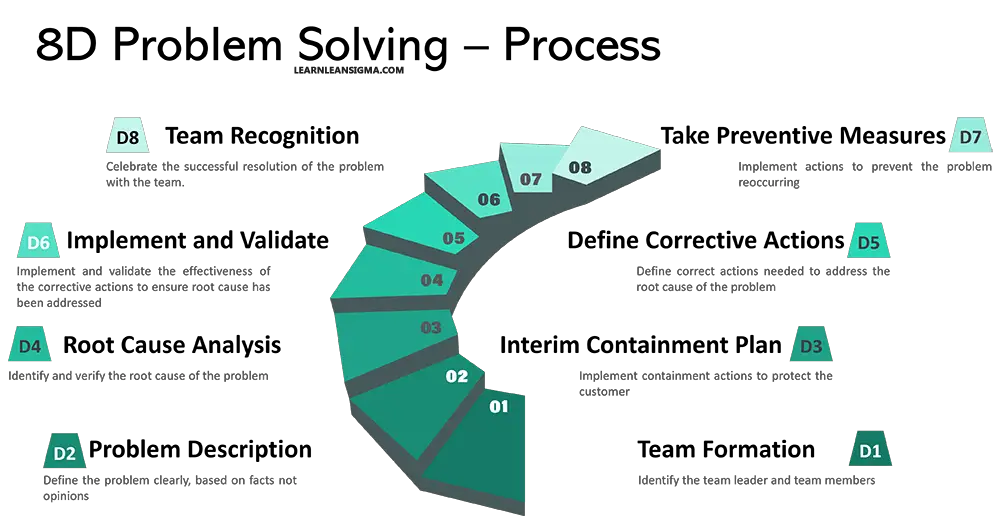
Related Posts
8d problem-solving: common mistakes to avoid, the evolution of 8d problem-solving: from basics to excellence, 8d: tools and techniques, 8d problem solving: the key to effective root cause analysis, 8d problem solving check list.
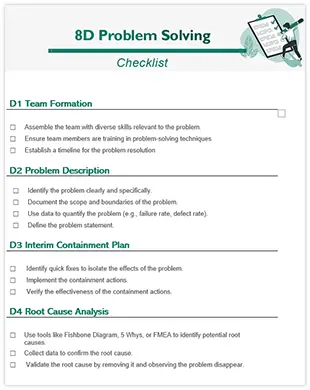
Helpful 8D Problem Solving Resources
8d report template.
Free to download 8D report template for conducting 8D Problem solving in a structured way.
8D Problem Solving Guide
Follow our step-by-step guide to learn how to conduct 8D Problem Solving.
8D Knowledge Test
Assess your’s or your teams understanding of 8D Provlem Solving.
When to use 8D Problem Solving
The 8D Problem-Solving Methodology is particularly well-suited for complex issues where the root cause is not immediately apparent and requires a team-based approach for resolution. It is most effective in scenarios where the problem has a significant impact on quality, safety, reliability, or customer satisfaction. Industries like manufacturing, automotive, aerospace, and healthcare often employ 8D to tackle recurring defects, compliance issues, and systemic failures.
The methodology is not intended for quick fixes or problems that can be resolved by an individual. Instead, it is designed for issues that need a structured, step-by-step approach to identify, correct, and eliminate the root cause permanently. The 8D process also serves as an excellent tool for cross-functional teams, as it brings together experts from various domains, thereby offering a multi-disciplinary perspective on problem-solving.
One of the key advantages of using 8D is its focus on data-driven decision-making, which aligns well with Lean Six Sigma principles. It’s a methodical approach that demands the collection of data at every stage, right from defining the problem to verifying the effectiveness of corrective actions.
Was this helpful?


What is Eight Disciplines (8D)
Provided By: Management and Strategy Institute
Download This Free eBook Here: What is Eight Disciplines (8D)
Table of Contents

Eight Disciplines (8D) is a problem-solving methodology designed to address, correct, and eliminate recurring problems impacting business operations, manufacturing, and product development.
Developed by Ford Motor Company in the 1980s, the 8D method has since been widely adopted across various industries as a comprehensive quality and process improvement tool. It combines teamwork, analytical tools, and a systematic approach to identify, solve, and prevent problems.
How & When 8D Methodology is Used
The 8D methodology is used when a recurring or significant problem has been identified and needs a structured approach to resolve. It is advantageous in scenarios where the root cause of the problem is not immediately apparent and requires thorough analysis to identify.
Industries like automotive, manufacturing, aerospace, and healthcare, among others, leverage 8D for its systematic approach to problem-solving and its emphasis on prevention.
The process is typically initiated once a problem is recognized and can significantly impact quality, safety, customer satisfaction, or costs. The 8D approach is about resolving the issue at hand and implementing a continuous improvement system that prevents similar problems from occurring.
The Eight Disciplines Explained
The 8D methodology consists of the following steps:
D1: Establish the Team
The first formal step of the Eight Disciplines (8D) problem-solving methodology, D1, focuses on establishing the team that will work on identifying, analyzing, and solving the problem at hand. This step is critical to the success of the 8D process, as the team’s composition, skills, and collaboration will significantly impact the effectiveness of the problem-solving efforts. Here’s a detailed look at D1, including its objectives, key considerations, and best practices for assembling an effective team.
Objectives of D1
- Form a Cross-functional Team : The primary objective is to assemble a team with members from various departments or functions relevant to the problem. This diversity ensures a broad range of perspectives and expertise, facilitating a comprehensive understanding of the problem and the development of effective solutions.
- Define Roles and Responsibilities : Clearly outline each team member’s roles, responsibilities, and expectations. This clarity helps in ensuring accountability and efficient collaboration throughout the 8D process.
- Empower the Team : Equip the team with the authority, resources, and support needed to investigate the problem thoroughly and implement solutions effectively. This includes access to data, tools, and decision-making authority.
Key Considerations for Establishing the Team
- Expertise and Knowledge : Select members with the relevant technical knowledge, problem-solving skills, and experience related to the problem area. Including experts who understand the processes, products, or services involved is crucial.
- Interpersonal Skills : Consider potential team members’ interpersonal skills and teamwork capabilities. Effective communication, collaboration, and conflict-resolution skills are essential for the team’s success.
- Representation from Affected Areas : Ensure that the team includes representation from all areas affected by the problem. This can include manufacturing, quality assurance, engineering, customer service, and other relevant departments.
- Leadership : Appoint a team leader with strong leadership skills and the ability to guide the team through the 8D process. The team leader should be capable of facilitating meetings, keeping the team focused, and ensuring progress.
Best Practices for Assembling an Effective Team
- Size of the Team : Aim for a manageable team size, typically between 4 to 8 members. This size allows for diverse input while maintaining efficient communication and decision-making.
- Training : Provide training or orientation on the 8D methodology and problem-solving tools to team members unfamiliar with the process. This ensures that all members are aligned and can contribute effectively.
- Commitment and Availability : Ensure selected team members are available and committed to participating in the 8D process. This may require securing support from management to allocate time and resources for the team’s activities.
- Communication Plan : Establish a communication plan outlining how the team will communicate internally and with external stakeholders. Regular updates and meetings should be scheduled to keep everyone informed and engaged.
In summary, D1 is about carefully selecting and preparing a team with the right mix of skills, knowledge, and perspectives to tackle the problem effectively. A well-established team sets the foundation for a successful 8D process, enabling thorough analysis, creative solutions, and sustainable improvements.
D2: Describe the Problem
After establishing a well-composed team in D1, the Eight Disciplines (8D) problem-solving methodology progresses to D2, which focuses on accurately and comprehensively describing the problem. This step is crucial as it lays the foundation for understanding the issue and guides the subsequent steps in the 8D process. An effective problem description ensures that the team has a clear and shared understanding of what needs to be addressed. Here’s a closer look at D2, including its objectives, key elements, and best practices.
Objectives of D2
- Define the Problem Clearly : Provide a clear, concise description of the problem, emphasizing specific, measurable details about what is happening, where, when, and to what extent.
- Establish Baseline Data : Gather and document quantitative data related to the problem to establish a baseline for future comparisons. This data helps in understanding the severity, frequency, and trends of the problem.
- Identify the Impact : Assess and describe the impact of the problem on operations, quality, customer satisfaction, costs, and safety. Understanding the impact helps prioritize the problem-solving efforts.
Key Elements of an Effective Problem Description
- Specificity : Avoid vague descriptions. Be specific about the details of the problem, including the affected product or process, locations, time frames, and quantities.
- Quantitative Data : Use data and evidence to describe the problem. Quantifiable information such as defect rates, downtime, and customer complaints provides a clearer picture of the problem’s magnitude.
- Use of Visuals : Where possible, use charts, graphs, photographs, or diagrams to illustrate the problem. Visual aids can enhance understanding and communication among team members and stakeholders.
- 5W2H Method : Employ the 5W2H method (Who, What, Where, When, Why, How, How Much) to ensure a comprehensive description. While not all elements may be known at this stage, addressing as many as possible strengthens the problem statement.

Best Practices for Describing the Problem
- Involve Relevant Stakeholders : Engage with individuals who are directly affected by the problem or who have firsthand knowledge of it. Their insights can contribute to a more accurate and detailed problem description.
- Avoid Assuming Causes : Focus on describing the problem without jumping to conclusions about its causes. The analysis of root causes is addressed in later stages of the 8D process.
- Initial Problem Statement Revision : Be prepared to revise the problem statement as more information becomes available. An iterative approach ensures the problem description remains accurate and relevant throughout the process.
- Document Everything : Maintain thorough documentation of the problem description, including all data, visuals, and stakeholder inputs. This documentation will be invaluable as the team progresses through the 8D steps.
In summary, D2 is about defining the problem in clear, specific, and measurable terms, utilizing data and evidence to outline the scope and impact of the issue. A well-articulated problem statement is essential for guiding the team’s efforts in investigating root causes, developing corrective actions, and ultimately resolving the problem effectively.
D3: Develop Interim Containment Plan
Following the establishment of the team and the detailed description of the problem, the Eight Disciplines (8D) problem-solving methodology advances to D3, which involves developing an interim containment plan. This step is crucial for preventing the problem from causing further harm or spreading while the team works on identifying and implementing a permanent solution. Here’s a deeper look at D3, its objectives, key considerations, and best practices.
Objectives of D3
- Minimize Impact : Implement immediate, temporary measures to contain the problem, minimizing its impact on customers, operations, and quality.
- Prevent Spread : Ensure that the problem does not escalate or spread to other areas, processes, or products.
- Maintain Operations : Keep operations running as smoothly as possible while the team works on identifying and implementing a long-term solution.
Key Considerations for Developing an Interim Containment Plan
- Quick and Effective Measures : The containment actions should be quick to implement and effective in addressing the immediate impacts of the problem. They don’t have to be the long-term solution but should provide immediate relief.
- Assessment of Risks and Side Effects : Evaluate the potential risks and side effects of the containment actions. It’s vital to ensure that these actions do not introduce new problems or significantly disrupt operations.
- Resource Allocation : Determine what resources (e.g., personnel, equipment, materials) are needed to implement the containment actions and ensure they are readily available.
Best Practices for Interim Containment
- Identify Containment Actions : Containment actions can vary widely depending on the nature of the problem. Manufacturing issues might involve segregating and inspecting inventory to remove defective products. In service-oriented processes, it might entail additional checks or temporary manual oversight.
- Communication and Documentation : Clearly communicate the need for, and details of, the containment actions to all affected parties. Document all actions taken, including who is responsible for implementing and monitoring these actions’ effectiveness.
- Monitor and Adjust : Continuously monitor the effectiveness of the containment actions. Be prepared to adjust or implement additional measures if the problem persists or side effects are observed.
- Link to Root Cause Analysis : While D3 focuses on immediate containment, it should be implemented with an understanding that it is a temporary fix. Insights gained during this stage can be valuable for the root cause analysis in D4.
Example of Containment Actions
For a manufacturing defect identified in a product line, containment actions might include:
- Inspecting All Current Inventory : Perform a thorough inspection of all current inventory to identify and segregate any defective products.
- Halting Production : Temporarily stop production of the affected product line until the root cause is identified and addressed.
- Notifying Customers : If defective products have reached customers, inform them of the issue, and offer replacements, repairs, or refunds as appropriate.
In summary, D3 is about quickly responding to the problem with effective interim measures that contain its impact. These actions are crucial for maintaining customer trust and operational stability while the team works on a permanent solution. Properly executed, the containment plan sets the stage for a thorough analysis and resolution of the underlying issue in the subsequent steps of the 8D process.
D4: Determine Root Cause(s)
After establishing an interim containment plan to manage the immediate impacts of the problem, the Eight Disciplines (8D) problem-solving process moves to D4, which focuses on identifying the root cause(s) of the problem. This critical step involves a deep dive into the problem to understand why it occurred in the first place, setting the stage for developing effective, long-lasting solutions. Here’s a closer look at D4, including its objectives, methodologies, and best practices.
Objectives of D4
- Identify Underlying Causes : The primary objective of D4 is to determine the fundamental reasons behind the problem, going beyond superficial symptoms to understand the underlying causes.
- Systematic Analysis : Employ a systematic approach to analyze the problem and its contributing factors, ensuring that all possible causes are considered.
- Evidence-Based Conclusions : Base conclusions on data and evidence, rather than assumptions or speculation, to ensure that the identified root causes accurately represent the source of the problem.
Methodologies for Root Cause Analysis
Several tools and techniques can be employed during D4 to facilitate thorough and systematic root cause analysis:
- 5 Whys : A questioning technique used to drill down into the details of the problem and uncover the root cause by repeatedly asking “Why?” until the fundamental cause is identified. [ Learn More ]
- Ishikawa (Fishbone) Diagram : A visual tool that helps identify and categorize potential causes of a problem across various categories (e.g., People, Processes, Materials, Equipment), facilitating a comprehensive analysis.
- Pareto Analysis : A statistical technique that applies the 80/20 rule to identify the few critical causes that contribute to most of the problem, helping prioritize focus areas. [ Learn More ]
- Fault Tree Analysis (FTA) : A top-down, deductive analysis method used to explore the causes of a specific problem or undesired event.
Best Practices for Root Cause Analysis
- Cross-functional Collaboration : Engage team members from different functions or departments to ensure a broad perspective is considered during the analysis. Different viewpoints can uncover aspects of the problem that might otherwise be overlooked.
- Data Collection and Analysis : Gather and analyze data related to the problem, including historical data, to identify patterns, trends, and anomalies that might point to root causes.
- Verification of Root Causes : Before concluding the analysis, verify that the identified root causes, when addressed, would prevent the recurrence of the problem. This might involve experimentation, additional data analysis, or consulting with subject matter experts.
- Document Findings : Thoroughly document the analysis process, findings, and evidence supporting the identification of root causes. This documentation is crucial for justifying the corrective actions in later stages and for future reference.
Example of Root Cause Identification
If a manufacturing process is producing a high rate of defective products, root cause analysis might reveal that the root cause is outdated equipment that cannot maintain the necessary precision for production. Alternatively, the analysis might uncover that the real issue is a lack of operator training, leading to improper machine setup.
In summary, D4 is about rigorously identifying the root cause(s) of the problem through systematic analysis and evidence-based conclusions. Understanding the underlying reasons why a problem occurred is essential for developing effective corrective actions that prevent recurrence, setting the stage for D5, where these solutions are selected and planned.
D5: Choose and Verify Permanent Corrective Actions (PCAs)
After identifying the root cause(s) of the problem in D4, the Eight Disciplines (8D) problem-solving process progresses to D5. This crucial step involves selecting, verifying, and planning the implementation of permanent corrective actions (PCAs) to address the root causes identified. The goal is to ensure that the problem is resolved in a way that prevents its recurrence. Here’s a detailed look at D5, including its objectives, considerations, and best practices.
Objectives of D5
- Select Effective Solutions : Choose corrective actions that directly address the root causes of the problem to ensure that it is effectively resolved.
- Prevent Recurrence : Ensure that the chosen solutions not only fix the problem but also prevent it from happening again in the future.
- Consider Impact : Evaluate the potential impact of the corrective actions on other processes, systems, or products to avoid creating new problems.
Key Considerations for Choosing Corrective Actions
- Effectiveness : Assess the potential effectiveness of each corrective action in addressing the root cause. This often involves a cost-benefit analysis to determine the most efficient solution.
- Feasibility : Evaluate the feasibility of implementing each corrective action, considering factors such as time, resources, and organizational constraints.
- Side Effects : Consider any potential side effects or negative impacts of corrective actions on other processes or areas.
Best Practices for Selecting and Verifying PCAs
- Brainstorming and Collaboration : Engage the team in brainstorming sessions to generate a wide range of potential corrective actions. Collaboration ensures diverse perspectives and innovative solutions.
- Pilot Testing : Where feasible, conduct pilot tests of the proposed corrective actions. This allows the team to assess their effectiveness and make necessary adjustments before full-scale implementation.
- Stakeholder Input : Involve stakeholders, including those who will be affected by the corrective actions, in the selection process. Their insights can provide valuable input on the practicality and potential impact of the proposed solutions.
- Documentation : Thoroughly document the decision-making process, including the rationale for selecting specific corrective actions and the results of any tests or evaluations conducted.
Example of Verifying Corrective Actions
If the root cause of a manufacturing defect was identified as outdated equipment unable to maintain precision, a potential corrective action might be to upgrade or replace the equipment. Before implementing this solution across the board, a pilot test could be conducted with one production line to verify the effectiveness of the new equipment in reducing defects. The results would inform whether this solution should be applied more broadly or adjusted.
Implementation Planning
Once the corrective actions have been selected and verified, the next step is to plan their implementation. This involves:
- Developing a Detailed Action Plan : Outline the steps needed to implement the corrective actions, including timelines, responsibilities, and required resources.
- Setting Milestones and Metrics for Success : Establish clear milestones and performance metrics to monitor the effectiveness of the corrective actions over time.
- Communication : Communicate the plan and expected outcomes to all stakeholders, ensuring alignment and support for the implementation phase.
In summary, D5 is a critical step in the 8D process, where the team selects and verifies corrective actions that will effectively address the root causes of the problem. By carefully considering each solution’s impact, effectiveness, and feasibility, and involving stakeholders in the process, the team can ensure that the chosen actions will provide a lasting resolution to the problem, paving the way for successful implementation in D6.
D6: Implement and Validate Corrective Actions
Following the selection and verification of permanent corrective actions (PCAs) in D5, the Eight Disciplines (8D) problem-solving process moves on to D6, which focuses on implementing and validating these corrective actions. This crucial step ensures that the solutions are effectively put into place and that they effectively resolve the problem and prevent its recurrence. Here’s an in-depth look at D6, including its objectives, implementation strategies, and best practices for validation.
Objectives of D6
- Implement Solutions : Execute the plan developed in D5 to implement the corrective actions that address the root causes of the problem.
- Monitor Implementation : Closely monitor the implementation process to ensure corrective actions are executed as planned and identify any issues or barriers to successful implementation.
- Validate Effectiveness : Verify that the implemented corrective actions have effectively resolved the problem and that there are no unintended negative impacts on other processes or areas.
Strategies for Implementing Corrective Actions
- Detailed Implementation Plan : Utilize the detailed plan developed in D5, which outlines the steps, timelines, responsibilities, and resources required for implementation. This plan serves as a roadmap, guiding the implementation process.
- Communication and Training : Communicate the implementation plan to all relevant parties, ensuring everyone understands their role. Provide training or support as necessary to facilitate effective implementation.
- Resource Allocation : Ensure that all necessary resources, including personnel, equipment, and financial resources, are available and allocated to support the implementation of corrective actions.
Best Practices for Validating Corrective Actions
- Establish Validation Criteria : Define clear criteria for evaluating the success of the corrective actions. These criteria should be directly linked to the metrics and goals established during the planning phase.
- Collect and Analyze Data : Gather data to assess the effectiveness of the corrective actions. This may involve measuring performance indicators, conducting inspections, or gathering stakeholder feedback.
- Adjust and Optimize : If the data indicates that the corrective actions are not fully effective, or if there are unforeseen negative impacts, be prepared to make adjustments. This may involve revising the actions, implementing additional measures, or conducting further analysis to identify additional root causes.
- Document Results : Thoroughly document the implementation process, the validation efforts, and the outcomes. This documentation should include data analysis, adjustments, and final assessment of the effectiveness of corrective actions.
Example of Implementation and Validation
If the corrective action involved upgrading equipment to address manufacturing defects, the implementation phase would include purchasing and installing the new equipment, training operators on its use, and integrating it into the production process. Validation would involve monitoring defect rates before and after the implementation, assessing production efficiency, and gathering feedback from operators to ensure that the problem has been resolved and that no new issues are arising from the change.
In summary, D6 is about taking the corrective actions from plan to action, ensuring they are implemented effectively, and validating their success in solving the original problem. This step requires careful planning, coordination, and data-driven validation to confirm that the problem has been addressed and to prevent its recurrence, setting the stage for preventive measures in D7.
D7: Take Preventive Measures
After implementing and validating the effectiveness of the corrective actions in D6, the Eight Disciplines (8D) problem-solving process advances to D7. This step focuses on taking preventive measures to ensure that the problem and similar issues do not recur in the future. D7 is about embedding long-term solutions into the organization’s processes, systems, and culture. Here’s a detailed look at D7, including its objectives, key activities, and best practices.
Objectives of D7
- Prevent Recurrence : Establish measures that prevent the original problem and similar issues from occurring again in the future.
- Systemic Improvement : Identify and implement changes to systems, processes, and practices to improve overall quality and performance, based on the learnings from the problem-solving process.
- Enhance Organizational Learning : Promote a culture of continuous improvement and learning by sharing insights and best practices derived from the problem-solving process across the organization.
Key Activities for Taking Preventive Measures
- Review of Related Processes and Systems : Examine other processes and systems that could be affected by the same or similar root causes. This broad review helps identify areas where preventive measures can be applied more widely.
- Modification of Standards and Procedures : Update existing standards, procedures, and documentation to incorporate the learnings and preventive measures identified during the problem-solving process. This may include revising work instructions, quality standards, training materials, and maintenance schedules.
- Training and Education : Conduct training sessions to educate employees on the new or revised standards and procedures. Ensure that all relevant personnel understand the changes and the reasons behind them.
- Change Management : Implement change management practices to facilitate the adoption of new or revised processes and systems. This includes communicating the benefits of the changes, addressing concerns, and providing support during the transition.
Best Practices for Taking Preventive Measures
- Root Cause Analysis for Prevention : Use the insights gained from the root cause analysis in D4 to identify potential vulnerabilities in other areas. By understanding the underlying causes, organizations can proactively address issues before they become problems.
- Engagement and Ownership : Involve employees at all levels in developing and implementing preventive measures. Foster a sense of ownership and accountability for quality and continuous improvement.
- Monitoring and Feedback Loops : Establish mechanisms for ongoing monitoring of the effectiveness of preventive measures. Encourage feedback from employees and stakeholders to identify opportunities for further improvement.
- Continuous Improvement Culture : Promote a culture that values learning from mistakes and proactively seeks improvement opportunities. Recognize and celebrate the contributions of teams and individuals to fostering continuous improvement.
Example of Preventive Measures
Suppose the problem-solving process revealed that a manufacturing defect was due to inadequate training on new equipment. In that case, preventive measures might include developing a comprehensive training program for all operators on existing and future equipment, revising the onboarding process for new hires to include hands-on training sessions, and scheduling regular refresher courses to ensure skills remain up-to-date.
In summary, D7 is about solidifying the gains made through the problem-solving process by implementing systemic changes that prevent recurrence of the problem and similar issues. By taking preventive measures, organizations can improve their resilience, enhance quality and performance, and build a culture of continuous improvement that drives long-term success.
D8: Congratulate Your Team
The final step in the Eight Disciplines (8D) problem-solving process, D8, serves a crucial role in recognizing and celebrating the efforts and achievements of the team that has worked through the complex process of resolving a problem. This step is about acknowledging the hard work, dedication, and collaboration that contributed to the successful outcome. Here’s an in-depth look at D8, including its objectives, significance, and best practices for effectively congratulating the team.
Objectives of D8
- Recognize and Reward Effort : Acknowledge the individual and collective efforts of the team members who contributed to identifying and implementing the solution to the problem.
- Reinforce Teamwork and Collaboration : Highlight the importance of teamwork, collaboration, and cross-functional engagement as key factors in problem-solving.
- Promote a Positive Culture : Foster a positive organizational culture that values problem-solving, continuous improvement, and employee contributions.
- Encourage Future Participation : Motivate team members and others within the organization to actively participate in future problem-solving efforts by demonstrating that their contributions will be recognized and valued.
Significance of Congratulating the Team
- Morale and Motivation : Celebrating successes boosts team morale and motivation, making members feel valued and appreciated. This positive reinforcement encourages continued engagement and commitment to excellence.
- Learning and Development : Recognizing the team’s achievements provides an opportunity to reflect on what was learned during the process, reinforcing best practices and lessons that can be applied to future challenges.
- Visibility and Communication : Publicly acknowledging the team’s work communicates to the wider organization the importance of the problem-solving process and the positive outcomes that can be achieved, promoting a culture of transparency and accountability.
Best Practices for Congratulating the Team
- Personalized Recognition : Tailor recognition to the team and its members, acknowledging specific contributions and achievements. Personalized recognition can be more meaningful and impactful.
- Formal and Informal Acknowledgment : Use formal and informal channels to congratulate the team. Formal recognition might include awards or commendations, while informal recognition could be a team lunch or handwritten notes.
- Involve Leadership : Involvement of senior leadership in the recognition process can significantly enhance its impact. Leadership acknowledgment underscores the value placed on problem-solving and continuous improvement efforts at the highest levels of the organization.
- Share Success Stories : Share the team’s success story across the organization through internal newsletters, meetings, or intranet posts. Highlighting the problem-solving journey and its outcomes can inspire others and promote a proactive problem-solving culture.
- Continuous Feedback Loop : Integrate recognition into a continuous feedback loop where teams are regularly acknowledged for their contributions to problem-solving and improvement initiatives, not just at the conclusion of an 8D process.
Example of Congratulating the Team
After successfully implementing corrective actions to resolve a production issue, a company might organize an all-hands meeting where senior management formally recognizes the team. Each team member could receive a certificate of appreciation, and the team leader might share insights from the problem-solving journey, highlighting key contributions from team members. Additionally, the team could be treated to a celebratory lunch or team-building activity, reinforcing the sense of camaraderie and achievement.
In summary, D8 is a vital step that closes the 8D problem-solving process on a high note, reinforcing the value of teamwork, dedication, and continuous improvement. By effectively congratulating the team, organizations recognize the immediate achievements and foster a positive culture that encourages ongoing engagement, learning, and excellence in problem-solving.

What about D0 (Discipline Zero)?
In some organizations, the Eight Disciplines (8D) problem-solving process includes an additional preliminary step known as D0 (Discipline Zero). D0 serves as a preparatory phase before the formal 8D process begins and is crucial for setting the stage for effective problem-solving.
The main objective of D0 is to plan and prepare for the 8D process. This involves identifying the need for an 8D, gathering initial information about the problem, and ensuring that the necessary resources and commitments are in place to support the process. It’s about getting ready to tackle the problem efficiently and effectively.
What are some Negatives associated with the Eight Discipline Method?
While the Eight Disciplines (8D) problem-solving method is widely regarded for its structured approach and effectiveness in addressing complex problems, some potential drawbacks and challenges are associated with its implementation and application. Here are some of the negatives or limitations that organizations might encounter when using the 8D method:
1. Resource Intensive:
The 8D process requires significant time and resources, including assembling a cross-functional team and dedicating time for detailed analysis and implementation of corrective actions. Smaller organizations or teams with limited resources may find it challenging to commit to the process fully.
Strategies to Overcome :
- Prioritize Problems : Use the 8D method for issues that have a significant impact on quality, cost, or customer satisfaction, ensuring that resources are allocated to problems that warrant the investment.
- Efficient Team Composition : Form smaller, more focused teams that include key personnel with the necessary expertise and authority to make decisions, reducing the resource burden.
- Leverage Technology : Utilize project management and collaboration tools to streamline communication and documentation, making the process more efficient.
2. Complexity and Overhead:
The structured and rigorous nature of the 8D process can add complexity and administrative overhead, particularly for relatively simple problems that might be resolved more efficiently with less formal approaches.
- Simplify Documentation : While thorough documentation is crucial, focus on streamlining and simplifying documentation requirements to the essentials, avoiding unnecessary complexity.
- Tailor the Process : Adapt the 8D methodology to fit the organization’s specific needs and problem types, simplifying steps where possible without compromising the effectiveness of the problem-solving effort.
- Incremental Implementation : Start with a pilot project to implement the 8D process on a smaller scale, allowing the organization to adjust and refine the approach before wider adoption.
3. Resistance to Change:
Introducing a structured problem-solving process like 8D can encounter resistance from employees accustomed to more informal approaches. Overcoming this resistance and fostering buy-in can require significant effort and change management.
- Communicate Benefits : Clearly communicate the benefits of the 8D process, including real-world examples of how it has successfully resolved problems, to build buy-in and enthusiasm.
- Involve Employees Early : Involve employees in implementing the 8D process from the beginning, seeking their input and addressing their concerns, to foster a sense of ownership and commitment.
- Celebrate Successes : Publicly recognize and celebrate the successes achieved through the 8D process, reinforcing its value and encouraging wider acceptance and participation.
- Change Management : Implement change management practices , including leadership endorsement, open communication, and training, to support employees through the transition to the new process.
The Eight Disciplines (8D) problem-solving methodology offers a structured and practical approach to identifying, solving, and preventing organizational problems. By emphasizing teamwork, systematic analysis, and continuous improvement, 8D helps organizations enhance their quality management practices, improve operations, and increase customer satisfaction. Through its disciplined approach, 8D equips teams with the tools and processes necessary to tackle complex issues, ensuring long-term success and stability in today’s competitive business environment.
Download this FREE eBook here: What is Eight Disciplines (8D)
Earn a FREE Eight Disciplines (8D) Certificate of Completion
Learn more:.
Learn more about process improvement methods through these programs:
- Lean Six Sigma Black belt Certification
- Continuous Improvement Manager Certification
- All Certifications
- Accessibility
Connect With Us
Copyright © 2022 MSI. All Rights Reserved.

- Lean Six Sigma
8D Problem Solving Report
8D is a problem solving method used globally, mainly in manufacturing industry by Quality Engineers and Operations managers. The purpose of 8D problem solving method is to identify, correct and prevent problems affecting customers and operational efficiency. It is a problem solving approach similar to PDCA cycle (Plan – Do – Check – Act).
8D stands for 8 Disciplines. It is a methodology that emphasizes “No problem should be repeated but fixed permanently”.
8D Problem Solving Method originally evolved during Second World War. But it became an official methodology in 1974, when it was used by US Government for its Military Operations as ‘Military Standard 1520’. Later it was adapted and popularized by Ford Motors with slight modification in the methodology.
As the name indicates 8D has 8 disciplines that any process or operations should follow to solve the problems occurring. The outcome of 8D is a report called ‘8D Report’ that records the problems, root cause(s) and corrective and preventive actions.
The below are the D’s in 8D approach:
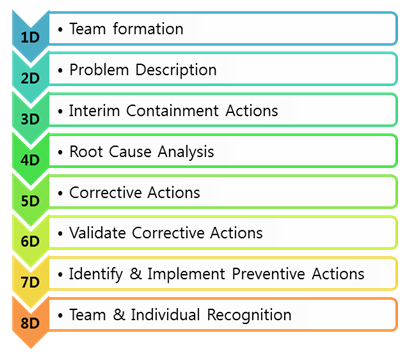
Figure 1: 8D Problem Solving Approach
1D – Team Formation: The first and foremost step not only in 8D but also in any other initiative or project is Team Formation, for any initiative cannot be successful without a right team. The team selected should be committed, competent, co-ordinated, cross-functional with representation from all teams, and should be knowledgeable in 8D methodology.
2D – Problem Description: After selecting the team, our concentration should be on detailing the problem. The team should collect details about the problem, for completely understanding the depth of the problem. All details should be data and fact based.
3D – Interim Containment Actions: Once the problem is described, before heading up to problem solving, the team should fix the effect of the problem, especially on customers. It might involve actions like isolating the items affected, replacing defective parts, before it reaches the customers. This step is mainly to prevent the problem from reaching the market and customers, which might become a competitive disadvantage and reduce customer loyalty.
4D – Root Cause Analysis: After taking containment actions, the team should involve in identifying the root cause(s) for the problem. Methods and tools like 5-Why Analysis , Fishbone diagram , Pareto Analysis , 7 Old QC tools , New QC tools etc. can be used for identifying the root cause. An important point to be noted is: Whatever method is used for RCA , it should be data & fact based.
5D – Formulate Corrective Actions: After successfully arriving at the root cause, the team should formulate corrective actions to be taken to correct the problem. Tools like Brain storming, Affinity diagram etc. can be used.
6D – Validate Corrective Actions: After arriving at the corrective actions, the team should validate whether the solutions are effective. There are several tools like Accelerated life testing , simulation etc. available for this purpose. Then the solution can be implemented in the process. The solution approach from step 4-6 should be repeated until the problem is completely eliminated.
7D – Preventive Action: Identifying and implementing corrective actions is only a temporary solution that keeps the system running or is like ‘Living with the problem by taking counter measures’. The permanent solution is to identify a potential long term solution that will not allow the problem (similar problems) from occurring into the system again. Sometimes corrective action will be a costly, time being measure. Preventive action makes changes in the system, upstream or downstream processes so that the entire system is modified or aligned for ‘Problem Free’ operations.
8D – Team and Individual Recognition: Once the problem is completely solved, the team and the extra-ordinary contributors must be rewarded and recognized appropriately. This will act as a motivation factor for other employees.
These are the steps of 8D methodology. To summarize, 8D is a holistic, systematic and proven methodology for problem solving.
Previous post: Change Management
Next post: Project Portfolio Management
- 10 Things You Should Know About Six Sigma
- Famous Six Sigma People
- Six Sigma Software
Recent Posts
- Control System Expansion
- Energy Audit Management
- Industrial Project Management
- Network Diagram
- Supply Chain and Logistics
- Visual Management
- Utilizing Pareto Charts in Business Analysis
- Privacy Policy

What is 8D ? 8D CAPA Report | Eight Disciplines of “Problem Solving”
“ 8D ” Methodology basically uses eight disciplines or principles of “ Problem Solving “. This Problem Solving Technique is widely used by quality engineers and managers of automotive industries.
This approach is also commonly used by other professionals working in Manufacturing, Government, Construction, Healthcare, IT/BPO, and other service sectors.
The objective/purpose of the 8D Methodology is to identify and define the problem statement effectively for necessary Corrective and Preventive actions – CAPA to stop/prevent the recurrence and occurrence of the problem.
The corrective actions are basically taken on the identified root cause to prevent the recurrence of the problem whereas preventive actions are taken in advance on potential causes of failure to prevent the occurrence of the problem.
The horizontal deployment of corrective action i.e. corrective actions implementations in other products, machines, or services sometimes referred to as preventive actions also.
The basic 7 QC Tools are commonly used in 8D Report generation and problem-solving methodology/approach/steps.
And apart from 8D , there are various Problem-Solving techniques or methodologies like PDCA Deming Cycle, Quality Circle , and Six Sigma – DMAIC , etc. that are commonly applied in a variety of organizations to identify and solve work-related quality problems.
8D CAPA Report is mainly demanded by all OEMs and IATF 16949 certified companies from their suppliers ( at least ISO 9001 certified) to solve customer complaints or quality-related issues.
Table of Contents
8D Approach | 8D Problem-Solving Steps

The eight disciplines for process improvement or problem-solving are as follows:
8D Step – D1: Establish the Team
- Identify team leader and team members.
- Establish a team of competent people with product/process knowledge.
- Cross-functional team-CFT members must be related to the concerned problem.
- Identify the team’s goals and objectives.
D2: Defining the problem
- Define the problem clearly using the 5W2H approach and Process flow diagram-PFD.
- Problem definition shall be based on facts, not opinions.
D3: Containment or Interim Actions
- Containment action is also known as Interim action or Short term action.
- Interim actions are immediate actions/first aid taken against the problem to stop defects/suspected material outflow at the customer end.
- Interim actions protect the customer’s production line from the arisen quality problem until we define the root cause and implement necessary countermeasures.
- Examples of containment actions are: Displaying of QAN-Quality Alert Note, customer complaint awareness training to all concerned, defective or suspected material/parts segregation at the WIP stage, store location, ready for the dispatch-RFD stage, supplier end, transit, and customer end.
D4: Identifying & Verifying Root Cause
Root Cause Analysis-RCA is a systematic approach to determining and identifying the Root Cause of the problem. We can use 7 QC tools,5 Whys, 4M or 6M factors, and a Fishbone diagram for RCA.
Steps for Root Cause Identification:
- Use the Brainstorm technique and Fishbone diagram to identify all possible potential causes related to your problem. Consider all 4M or 6M factors in potential cause identification.
- Verify/Validate the identified potential causes.
- Now, Select the best potential cause that contributes to the problem/effect.
- Drill down the selected potential cause using the 5-Why approach to arrive at the root cause of the problem.
- Identify the root cause on both the Occurrence and Detection or Inspection side.
- Verify the root cause for necessary measures.
Note: Don’t end the root cause with the operator’s negligence, lack of training, etc. while identifying the root cause using the 5Why tool. The problem always occurred when there is a gap in the system/procedure/standards.
D5: Identify Permanent Corrective Actions-PCA
- Identify and Select the permanent corrective actions that address and correct the root cause. In other words, the selected PCA will resolve the problem of the customer.
- Solutions/PCA determined to be the best of all the alternatives.
- Document and verify the Permanent Corrective Action (PCA).
D6: Implementing the Permanent Corrective Action
- Implement the best permanent corrective actions (PCA) and ensure effective monitoring of implemented actions.
- Detect any undesirable side effects of implemented corrective actions.
- Return to root cause analysis, if necessary. In other words, if a still problem exists, you may need to fine-tune your actions or re-analyze the problem to identify a new root cause.
D7: Preventive Actions
- Ensure horizontal deployment of corrective actions, i.e. Ensure similar types of problems will not occur in other machines, products, and services.
- Update the Systems, Processes, Procedures, and Documents like PFC , control and FMEA to prevent a recurrence.
- Implement Poka-Yoke (mistake-proofing or error-proofing) to make the system or processes safer and more reliable.
- Ensure effectiveness/sustenance monitoring of permanent corrective actions.
8D Step – D8: Team Recognition
- Congratulations to your team.
- Celebrate the successful conclusion of the problem-solving effort.
- Organization to express thanks to the team.
- Document lesson learned card-LLC and display at all respective areas.
You’ll also like:

Share this:

Take advantage of your time, International Six Sigma Inc. offers both Instructor-led Live Virtual classes as well as Online Self-Paced training . Enroll Today!

8D Process: Its Importance and Advantages
The 8Ds — also known as the 8 Disciplines — Problem Solving Process is a team-oriented methodology that is mainly used to identify, correct, and eliminate recurring problems.
The methodology focuses on the origin of a problem by determining the root cause and establishes a permanent corrective and preventive action accordingly. It is an 8 tier process with integrated basic problem-solving tools.
This article will help you looks at 8D best practices how it can be helpful for manufacturers to better understand tools and techniques to address nonconformances and reduce risk.
History of 8D Problem Solving Process
There was a dire need for a team-oriented problem-solving strategy based on the use of statistical methods of data analysis. Ford Motors during World War II were manufacturing war vehicles in bulk. To ease up the assembly lines and the entire management in general, the executives of Powertrain Organization wanted a methodology where teams could work on recurring problems.
In 1986, the assignment was given to develop a manual and a course that will teach a new approach to solving tough engineering design and manufacturing defects. The manual for this methodology was documented and defined in “Team Oriented Problem Solving (TOPS)”, published in 1987.
The manual and courses were led at World Headquarters in Dearborn, Michigan. Subsequent changes and revisions were made based on the feedback from pilot sessions. The materials were extensive and the 8D titles were mere chapter headings for the steps in the process. Ford also refer to their current variant of the 8D process as G8D (Global 8D)
Use of 8D Process in Military
The US Government recognized the full caliber of the 8D process. During World War II, they standardized a process as Military Standard 1520 “Corrective Action and Disposition System for Non-confirming Materials”
Their 8D process was used to identify, correct, and eliminate recurring problems, whilst the methodology was useful in product and process improvement. It established a permanent corrective action based on a statistical analysis of the problem. It also focused on the origin of the problem by determining the root cause.
The 8D approach
The 8D model establishes a permanent corrective action based on statics and data of the problem. It focuses on the origin of the problem by determining its root causes. The earlier 8D models comprised of eight stages, the model got changed as time progressed. It was later expanded by an initial planning stage.
The stages (or Disciplines) are as follow:
D0 — Plan adequately
Proper planning and preparation is of utmost necessity before taking any action. So, before forming a team for the project, you’ll need to consider the following:
- Problem description
- Timeframe of the task
- Amount of resources
D1 — Establish your team
Create a diverse team with extensive portfolios. Make sure they have enough experience so that they can lead to the best quality inputs and complete solutions. For teams to function smoothly, define clear roles and responsibilities.
D2 — Describe the problem
The 8D methodology focuses on describing a problem objectively, capturing every vital information. During the analysis, a loop of 5W1H (why, what, who, where, when, and how) should be applied to develop a clear problem description.
D3 — Contain the problem
Projects that are big and take days to run a single task on them require a temporary problem containment plan to minimize the impact of a problem until a permanent solution is found. On developing the plan based on hypothetical cases, the resources for addressing the main problem can be released.
D4 — Identify the root cause
When the problem is temporarily contained, you can work on identifying the root cause of the nonconformance. You can use the 5W1H framework to understand the problem in-depth, or the Fishbone diagrams to categorize visually, or Pareto Charts to identify the vital causes.
D5 — Identify corrective actions
Once the root cause is recognized, the team can start brainstorming permanent corrections to identify the best long-term solution. Brainstorming with the team along with taking help from tools like affinity diagrams can help in organizing ideas.
D6 — Implement and validate corrective actions
Once a solution is identified, the management needs to implement and verify the corrective action. The PDCA (plan-do-check-act) approach is beneficial in this stage to do small-scale testing. To successfully implement a permanent change, a project plan should incorporate:
- Project plan development for implementation
- Communication of the plan with stakeholders
- Validating improvements using measurements
D7 — Implement preventive actions
A complete solution always provides no reoccurrence of problems. Even if you have created a complete solution, you should still work on preventive measures (after all, better today than tomorrow!).
In this stage, teams must consider actions that include updating audit process questions and verifying corrective actions periodically to reduce risk in processes. Teams can utilize the Poka-Yoke/Error Proofing methodologies to run tests to find defects.
D8 — Recognize team and individual efforts
At the end of the day, everyone wants their work to be recognized. Don’t be shy about that. Celebrate the team’s success and congratulate individuals for their work contribution. Doing such will facilitate motion and employee engagement while helping the organization to improve quality control.
Six Sigma tools that synergize with 8D
8D has become one of the leading frameworks for process improvement. It is robust and can mix easily with other prominent methodologies such as Six Sigma.
The following are improvement tools often used in Six Sigma processes. Learn how the addition of 8D can improve the process even further.
DMAIC – Lean Six Sigma
The DMAIC process is a data-driven cycle for process improvement. It is designed for businesses to identify flaws, errors, defects, or inefficiencies in a process.
Learn more on DMAIC and the process here .
In terms of combining 8D:
- One can use DMAIC to identify the root cause as in step D4
- One can implement the same technique to better understand prospects for corrective actions in steps D5 & D6
FMEA – Failure Mode & Effects Analysis
FMEA helps in understanding the potential for problems and making preemptive preparations to avoid them. This methodology is used majorly by Risk Management teams.
FMEA & 8D:
- 8D can use information gathered during an FMEA process to identify potential problems and the root causes.
- The information gathered during the FMEA process can be reused to feed into representational diagrams like Ishikawa (Fishbone) diagram.
- 8D brainstorming data can be used for new design processes. This allows the FMEA to take actual failures into account, thus producing effective results.
- Database from previous FMEA can be used as a benchmark for root causes of the problem to inform on 8D process development.
Pareto Charts
Pareto charts are majorly used to analyze data on the frequency of problems/causes in a process. It helps in understanding the impact of different variations of input and outputs via data and graphical representation.
- In relation to 8D, Pareto charts help in prioritizing which root cause to target based on which will have the greatest impact on the improvement process.
The 5 Whys is a deductive reasoning technique that asks “Why?” five times. The logic here is to ask the same question (WHY?) over and over again, making the reasoning process dig deeper into the complexity of a problem from a single point of focus.
When someone reaches the “5th Why?”, they should have something that has a high likelihood of being a root cause.
Benefits of 8D Problem Solving
8D focuses on teamwork. The framework’s philosophy is to encourage teams as a whole and individually. It’s a pragmatic methodology, i.e. a fact-based problem-solving process.
One of the main strengths of 8D is its focus on teamwork. 8D philosophy encourages the idea that teams, as a whole, are more powerful than the sum of the individual qualities of each team member.
Here are a few of the benefits that you can expect from the 8D problem-solving process:
- Institutes a structured and consistent problem-solving approach within an organization
- Enables individuals to become more effective at problem-solving
- Encourages team-based approach
- Helps ensure customers receive a timely and effective response to any concern
- Supports the requirements of quality management systems for corrective action, problem-solving, and continual improvement
- Helps in avoiding future problems by solving them in the present time
- Reduces Cost of Poor Quality (COPQ) by using the lessons learned in process improvement actions
- Assists organizations to comply with the customer-specific requirement for management concerns
SixSigma.com offers both Live Virtual classes as well as Online Self-Paced training. Most option includes access to the same great Master Black Belt instructors that teach our World Class in-person sessions. Sign-up today!
Comments are disabled for this post.
At home or workplace, we have you covered
Training Options
More than 500 locations
Classroom Training
Learn anytime, anywhere
Online Training
Live instructor-led training
Webinar Training
Customized training programs
On-site Training
Accelerated training programs
Blended Training
For streamlined business plans
Operational Excellence
Exclusive consulting services
Consulting Services
Fully customized programs
Group/Corporate Training
International six sigma inc. accreditation & affiliations.

Email: [email protected] Toll Free in the US: (866) 409-1363
Courses / Training

Home > Quality Management > The 8D Problem-Solving Method: What is it And How To Use It
The 8D Problem-Solving Method: What is it And How To Use It
Free Counselling :
IN +91 9899577620
US +1 2093823469
Table of Contents
The 8D ( 8D Problem-Solving Method ) method, also known as 8 disciplines, first appeared in Ford’s 1987 “Team-Oriented Problem Solving” manual. It is a tool that has stood the test of time and has become the first solution used by the company known today as Global 8D. Although the 8D method has been around for years, many companies still face the problem of low resolution and poor use of fixes.
Eight Laws of Problem-Solving ( 8D Problem-Solving Method ) are an efficient, effective, and proven way to identify the root cause of a problem, plan a quick solution, and prevent a solution, treatment, and recurrence of the problem. If your product is faulty or does not meet customer expectations, the 8D is a great first step toward improving quality and reliability. The 8D has become very popular with manufacturers, installers, and workshops worldwide due to its efficiency and ease.

Organizations can benefit from improving their production processes and preventing problems that can hinder productivity. This approach provides businesses with the necessary and practical tools to increase efficiency and take action when necessary.
The 8D Problem-Solving Method is the process of teaching and improving quality and eliminating problems. Here we will show you a step-by-step troubleshooting tool to help you identify the problem and identify issues and errors. It also helps identify root causes and take steps to resolve and prevent problems identified in the process. So, let us look at the steps:
1. D0: Planning and Preparation-
Planning and proper planning is a good start before taking action. The process begins with devising a plan and analyzing the problems the organization wants to solve. In this step, company leaders combine information from different sources and generate ideas. In general, at this stage, they identify the problem that needs urgent attention, the main resources that can be used to solve the problem, and the parties involved in the resolution process. The planning phase forms the basis for the next step.
Therefore, before building a team, you should consider:
- Problem description
- The time frame for resolution
- Resources needed to complete the job.
2. D1: Formation of a Team-
This process is based on the creation of groups that will be part of the problem-solving process. During teamwork, the team leader will usually select someone with experience on the job and identify areas to consider in hiring professionals with skills in these areas. The group may also choose a leader to lead its efforts in the problem-solving process.
Building teams to do the 8D Problem-Solving Method is a weak spot for many organizations. Collaborating with people from relevant organizations is important because you cannot solve the problem without first-hand knowledge. If a part problem, the engineer responsible for the design should be in the team. If a production problem, it should be walked around by the staff from the special work area. Do not make the mistake of thinking that the 8D is a job only a competent person can do at their desk.
3. D2: Describing Problem-
The main purpose of the 8D approach is to accurately and objectively describe the problem so that all important information is captured. This step involves writing down detailed information and information to describe the problem, and this is another area where people run into a lot of trouble. Problem definition may mean walking the field to observe the problem on the production floor, reviewing quality data, and/or confirming/not validating the problem.
Organizations can further identify and solve the problem by identifying the problem. During this time, the team reviews issues that need fixing, and management maintains good communication with everyone on the team. Describe the situation in meaningful terms to help identify the potential and type of problem. Often, at this stage, the team writes problem statements, gathers information, and creates diagrams and charts to add to the project.
4. D3: Problem Containment Planning-
Sometimes it is necessary to develop a temporary problem management plan to reduce the impact of the problem until a permanent solution is found. New methods are needed to fix the problem until a permanent solution is found. Problem-solving is a process that takes time and goes through many stages. It is important to have a contingency plan when dealing with serious and persistent problems. Issue management can help reduce the immediate impact of an incident on a product or customer. Temporary protection plans often use quick, easy, and inexpensive measures that the team can reverse at a later stage if needed. With advice, it is important to analyze the results and monitor the situation carefully to prevent further damage.
Temporary protection minimizes the impact of the problem during a permanent solution, which is especially important when product quality or safety is at risk. Many automakers make the mistake of stopping at this point and causing confusion and correction. Sorting materials or clearing clutter only fixes the symptoms, not the cause. The result: repeated problems, higher costs, and loss of business.
5. D4: The Root Cause Analysis (RCA)-
There are many tools available to identify the true root cause of a problem. With the issue temporarily resolved, you can now begin to identify the cause of the inconsistency.
Once the interim plan is in effect, the next step will be an in-depth analysis of the root of the problem. The team examines each potential resource through in-depth analysis and testing. They bring in all relevant test data and discuss the unidentifiable details of the method. This issue is common and can help organizations better identify problems and prevent their recurrence in the future. Organizations often use marketing and visualization tools such as Five WHYs, the Fishbone diagram to visualize the cause, and the Pareto charts to identify root cause analysis.
6. D5: Analyzing Permanent Corrective Action-
Once the team has identified the source of the problem, we can decide what the best solution is. Networking with tools such as social mapping can help plan ideas and identify best practices through relationships.
After determining the best solution, the team evaluates corrective action against the root cause of the problem and escape points. With this information, they can compare corrections and write their results. At this stage, they can also make a risk assessment of each solution they create and choose the most appropriate one. Brainstorming combined with tools such as affinity diagrams helps organize ideas based on relationships and determine the best course of action.
7. D6: Implementing & Validating Permanent Corrective Action-
Management should be involved in verifying correct operation and this means that they must be present in the workshop to measure performance and in regular reviews of key performance indicators (KPIs). Leadership should be exemplified by examining the process from the paying customer’s perspective. It is worth noting that the 6 steps of the 8D Problem-Solving Method are when you are finally ready to use the correction, demonstrating the critical role of planning in this process.
Once a solution is identified, management should implement corrective actions using the PDCA (Plan Do Check Act) process with small tests before expansion. So, keep track of the results and tweak the fix to get the desired results. To achieve and implement a permanent change, the strategic plan should include:
- Creating an action plan
- Communicating the plan to all stakeholders
- Recognizing improvement using metrics
8. D7: Preventing Recurrence-
Once the best solutions have been identified and tested, it is important to pursue permanent corrective action to eliminate roots and escapes. Generally, the organization pulls back the management plan from time to time, creates an action plan for the right action, and then communicates it to all stakeholders. To implement the plan, organizations monitor instant results and results over time. It also monitors the effectiveness of permanent fixes.
The organization should decide to take steps such as updating the process of checking questions and performing regular preventive maintenance on them, ensuring defect-free products for high-risk processes, and rejecting to avoid risking other processes.
9. D8: Recognizing Team Contributions-
When the problem is solved, the last step is to congratulate the team. Because teams need feedback to achieve great results, it is important to recognize their efforts and share their success across the organization. This increases motivation and employee engagement while helping you develop quality control, implement process improvements, and manage change as you grow.
At the final stage of the process, the team reviews their work and discusses the project and its achievements. Effective communication and comparison before and after the 8D Problem-Solving Method process helps the team. Awareness of personal effort and feedback is important during this period as it can increase job satisfaction.
About Henry Harvin 8D Analysis Course:
Henry Harvin’s 8D Problem-Solving Method Analysis course is designed to identify the root cause of a problem, develop a short-term solution strategy, and implement long-term solutions to prevent the recurrence of the problem and 8D gives you an understanding of Root Cause Analysis. It’s not just about solving problems. However, it can help prepare your engineering team for the future.

Rating: 9.8/10
Learning Benefits:
- Learn and find clear information on 8D analysis courses.
- Learning various 8D Problem-Solving Method analysis principles.
- Understand government processes and products.
- Design advanced knowledge using project management.
- Manage performance, and understand capacity and growth.
Youtube URL: https://www.youtube.com/watch?v=IX4eMOJC4VE
Other Courses
- LEAN SIX SIGMA IN IT COURSE
- ADVANCED STATISTICS FOR SIX SIGMA COURSE
- POST-GRADUATE PROGRAM IN LEAN SIX SIGMA
Benefits of the 8D Problem-Solving Method include a better way to find the root cause, establish the necessary measures to eliminate the root cause, and apply the right treatment. The 8D method also helps find the control that is causing the problem to escape. The purpose of learning escape points is to improve management’s ability to identify failures or their causes (when and when they occur again). Finally, the prevention cycle examines the sequence of events that allowed the failure and the process that caused it to exist.
The 8D Problem-Solving Method approach is universally applicable to any organization that needs a solution. However, there are some industries and businesses that have been successful using this 8D method, such as manufacturing, the automotive industry, engineering companies that produce products, and large and medium-sized businesses.
Recommended Blogs
- Amazon Lean Management: The Six Sigma Case Study in 2023
- Top 20 Quality Management Tips For Business
- Importance of Six Sigma Quality and Scenarios in 2023
- Quality Function Deployment: An Overview
Youtube URL: https://www.youtube.com/watch?v=-9MUBLT0DjI
To complete the 8D process, the following are important: i. Good team. ii. A correct description of the problem. iii. Not skipping the 8D Problem-Solving Method steps. iv. Cooperation within the team and management support.
Some errors continued to occur as the team tried to locate the source of the problem and implement the correct solution. To prevent these defective products from reaching consumers, interim containment ensures that the defect remains in place until the problem is completely resolved. If the customer reaches the wrong location, it can lead to liability, failure, and customer dissatisfaction.
The 8D Problem-Solving Method report is a document used to document the 8D process, detailing the implementation of solutions and evaluating the effectiveness of solutions.
The Future of AI: How Will AI Impact Programming Career?

Top 9 Amazing Tally Courses in Delhi
Related posts.

Top 10 Benefits of Quality Management System

Top 15 Quality Management Interview Questions and Answers

Difference Between Quality Assurance and Quality Control

Quality Management Interview Questions and Answers

What Is Quality Planning And Why Is It Important?

Quality Management Tools: A Complete Guide
Join the discussion cancel reply.
Save my name, email, and website in this browser for the next time I comment.
.webp)
Our Career Advisor will give you a call shortly

Just purchased a course
Type above and press Enter to search. Press Esc to cancel.
Noida Address:
Henry Harvin House, B-12, Sector 6, Noida, Uttar Pradesh 201301
FREE 15min Course Guidance Session:

8D Methodology – Problem Solving tool
Table of Contents
Disciplined Problem Solving is essential
Hello everyone in this post we learn & explain 8D analysis problem-solving methodology.
Introduction of 8-D Methodology
Today we want to explain the
- Purpose of the eight disciplines for team oriented problem-solving
- Understand the importance and the interactions of each of the disciplines
- Use the 8D methodology for problem solving, and for corrective and preventive action implementation.
We established cause-and-effect relationships , therefore we built hypotheses for improvement and used statistical analyses to verify these improvement ideas. And then finally we established long-term sustainability through process control.
Now, as we said, business success means reducing the variation and centering our critical to quality parameters leading to reduced costs, reduced defects, improved productivity, reduced cycle time, better matching our customer needs, so that which may lead to an increased organisational profit.
In this post, we want to introduce the 8D, which is a problem-solving methodology. So 8D focused on identifying, correcting and preventing a problem. The 8Ds have their origins in the United States military and in the automotive industry. Ford documented the 8D method in the late 1980s. And the method defines eight disciplines or stages, and there’s a new stage added, state zero.
8D is used for handling customer complaints and re-occurring process problems. Once it happens you grab a team, then you need to understand the problem and take containment actions. You need to find the root cause and choose a corrective action, implement the corrective action and then learn a defined prevention for the future before you release and congratulate the team.
what is a problem?
Now, we looked earlier at control charts which proposed by Dr. Shewart, and he talked about two different sources of variability in a process, either common causes or special causes. This type of variation is explain in the post of Statistical Process control.
Common causes is accepted as part of a process. Whereas special cause variability on the other hand produces disturbances in the process and usually increases the variability beyond acceptable levels. And special cause should be then discover and eliminated.
It is important to fix the problem, don’t fix the blame…..!
So as we just said, common cause variability, we would work on improving that with the Six Sigma methodology, going through the DMAIC cycle. But for something that is out of control, a problem, we can use the 8 D problem-solving methodology which we then apply to bring long term stability to our process.
Anything outside of the specifications is a defect. Now, often if we see a special cause, we could have a defect.
So how does this relate to 8D?
Well again, you know with some sort of overlap possibly, the 8D analysis helps bring stability to our process. Okay, then let’s go through the different steps of the 8D problem-solving methodology.
What is 8D?
- 8D is a disciplined process which addresses problem solving in a methodical and analytical way
- Each step of the 8D analysis Process is preceded by letter ‘D’ which stands for discipline.
- The 8D process seeks to define and understand a problem, so that by taking this approach we can continuously improve quality by eliminating the causes of problems and prevent their re-occurrence.
- Each discipline has an input and output
- the output of one step becomes input for next step.

D0- Prepare for problem solving process OR Awareness of problem
Evaluate the need for problem solving process when a symptom / problem is noted
- Does the severity, urgency, size and / or complexity of the symptom exceed the ability of one person to resolve?
Determine if there is a need for an Emergency Response Action to protect an internal or external customer
- Emergency Response Action entails reworking and replacing nonconforming or suspect material(s). In other words, sometimes this may include sorting or reworking on-site.
- The whole idea of an Emergency Response Action is to protect the customer.
- Emergency Response Action is different than an Interim Containment Action (D3)
If I had six hours to cut down a tree, I would spend four hours sharpening the axe”. Abraham Linken

D1- Establish the Team
The first D1 in 8D methodology is team formation.
Select a Champion
- The Champion is a designated member of management who has the authority to sanction the improvements
Select a Team Leader
- The team leader is a spoke person for the team. He ensures that progress is being made, schedules meetings and coordinates the efforts of all the team members
Select Team Members
- CFT can be created at any level of the organization. However, they should be formed as close to the process or problem and its solution as possible
- CFT typically consists of four to seven (4 to 7) members.
- Appropriate specialists can be team members or may be invited to meetings as needed.
- Most of the members are usually those affected by the problems the team is formed to solve.
Generic rules
- Team should establish ground rules
- Finalize the Decision-making criteria / Model How the decision is made
Now, then you want to form a team . Team leader should be someone who has the right expertise to solve the problem, generally the owner of the process or the area where the process occurred. And so, this person is responsible for meeting any requirements and expectations of the organization or from external customers, for example, like how fast the problem should be solved. But here, this is more the expert, the area leader.
8D moderator – not an expert.
And then finally the most important is the team members, these are people that really are the experts assigned to work on the problem with their specific knowledge, and they then need to work. So we’ll have experts, specific knowledge, They need to have the time allocated and the resource allocated so that they can work on the problem, and they need to work within the constructs of the 8D, so that this can be resolved in the proper manner.
D2- Describe the Problem
The purpose of D2 is to describe the internal / external problem by
- Identifying ‘What is wrong with what’
- Detailing the problem in quantifiable terms
Use 5W / 2H Questions
- Who – Identify which customers complaining? / Who is affected?
- What – Identify the problem adequately and accurately.
- When – Timing …When did the problem start?
- Where – Location …where is it occurring?
- How – In what mode or situation first the problem occurs?
- How many – Magnitude …quantify the problem.
- Why – Any known explanations contributing to the problem should be stated.
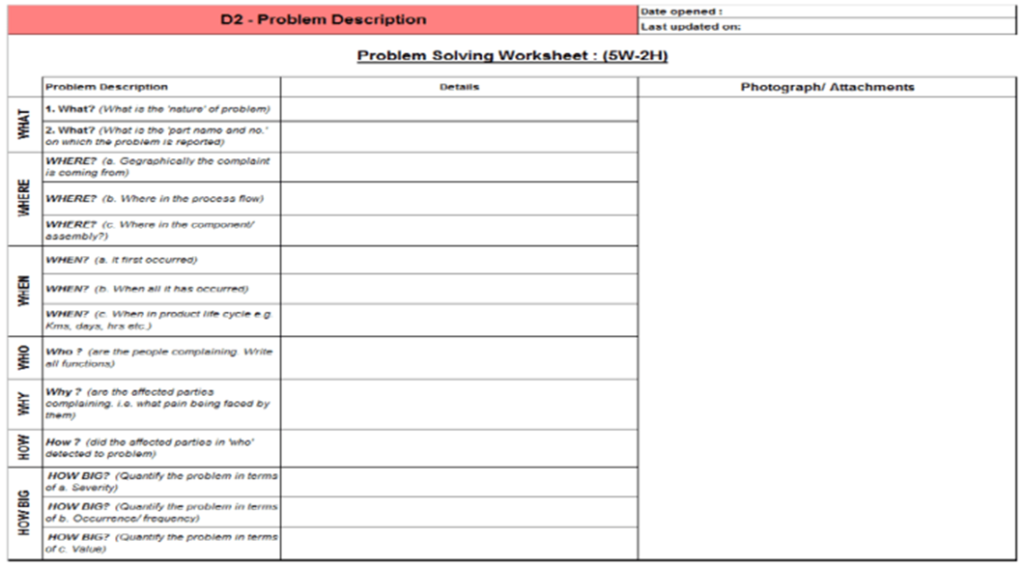
Above all the questions of 5W-2H, Read more about the 5W 2H by click here .
Conduct “Is / Is Not” Analysis (to bring in more clarity about the problem)

D1- Establish the Team D2- Describe the Problem

D3- Develop the Interim Containment Action
Define and implement interim (containment) actions to isolate the effect of the problem from any internal / external customer until corrective action is implemented
Verify the effectiveness of the containment action, so the quantifiable verification can be provided by
- Check sheets
- Dot Plots and Histograms
- Control Charts
- Paynter Charts
Protect the customer Containment actions are used to buy time. So the principal objective is to protect the customer from experiencing additional problems.

In the Interim containment action, we have identified
1. Whether suspect material is segregate?, quarantine and tagged in the entire supply chain? (Field, warehouse, FG, in process, receipt stores and in transit?
2. Whether details are capture? w.r.t. quantity, cut off numbers, implementation dates
3. Whether specific immediate actions are clearly determine? which may include additional inspection / checks, additional operations etc.
4. Whether details are capture? w.r.t. ion qty., cut off nos., implementation dates etc.
5. Whether documented & clear work instructions are provided for the above containment and immediate actions so that there is no ambiguity while implementation & execution?
6. Whether above is communicate through document? or mail to all concerned and affected parties?
7. Whether adequate supporting data is available? & included in 8D analysis report w.r.t. effectiveness & implementation of interim actions (both containment & immediate)?
8. Whether % effectiveness of each action clearly identified based on fact and team consensus?
D4- Define & Verify Root Cause and Escape Point
Generate Potential Root Causes
Brainstorm using Cause and Effect Diagrams :
Find out the potential / possible causes using the cause and effect diagram , In addition filter out the all possible causes to very few probable causes. Then next use the cause analysis to find out valid cause for the problem generation and escape cause.

Use Five why for the potential causes to get the system root cause:
After found out the valid cause use the Why-why analysis tool, so that we get the root cause for problem generation and escape.

D5- Choose and verify Permanent Corrective Actions
Implement the corrective action to ensure the root causes have been removed. In other words, verify the permanent corrective action are implemented as intended .
For implementation of corrective action plan out the implementation and setup some matrix to verify long term effectiveness.
D6- Implement and Validate PCA
- Define & implement the appropriate corrective actions
- Choose on-going controls (e.g. Process sheet ) to ensure the root cause is eliminated
D7- Prevent Recurrence
However behind all root causes there are systematic issues. Therefore which need fixed to avoid the recurrence of this cause to avoid the same problem in future. So that goal of prevent recurrence is to change the system that allowed the problem to occur in the first phase
Preventing recurrence
- Notify all personnel of the resolution areas
- Update all relevant documents – Process Flow Diagrams, FMEA , Control Plan, check sheets, etc.
- Update change control records
Look for new opportunities
- Examine – similar processes
- Other locations
- Other parts in part family
Log lessons learnt from this 8D analysis study.
D8- Recognise team & Individual contributor
In this category, we have to ensure
1. Whether lesson learnt is document? and discussed with team?, 2. whether opportunity for horizontal deployment is identify? 3. Whether plan is work out? 4. Whether complete closure for 8D analysis is document for future references? share with other members in the organization, so that learning are effectively utilize. 5. Whether tangible & intangible benefits are calculate? & included in the overall report?
And finally, you’ve got then the release and the signature of the author of the report and the final date of the closure. And once all 8D steps done, then the 8D analysis can be closed.

Related Posts

Cost of Quality | Quality engineer essential guide
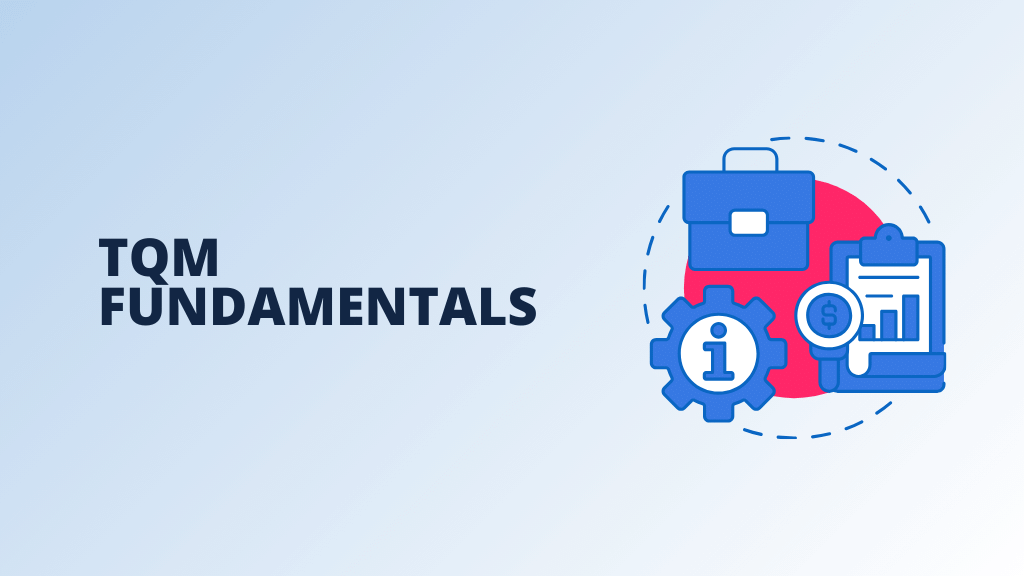
Total Quality Management (TQM) Fundamentals

SIPOC – The complete guide

Root cause analysis

7 Management and Planning Tools

CAPA | Corrective Action & Preventive Action
- Careers with Sofeast
- Lifecycle Assessment (LCA) and Environmental Product Declaration (EPD) Requirements: What Manufacturers need to know
- How To Do an LCA? (Lifecycle Assessment)
- China Fulfillment Center (Dongguan)
- Co Packing in China for Buyers with Local Suppliers
- Defective Product Repair and Rework
- Kitting and Assembly (Dongguan, South China)
- Sofeast Fulfillment Benefits
- 100% Inspection, Repacking, and Shipping
- Different Types Of Batteries For Electronic Products (Importer’s Guide)
- Directions To Sofeast’s Shenzhen Office
- Checkout-Result
- How To Use Sofeast’s Booking System For Product Inspections
- The Sofeast Client Charter
- Contract Manufacturing near Shenzhen, China
- Supplier Improvement Audit
- Supplier Self Inspection Enablement For Importers From Asia
- Manufacturing Troubleshooting To Solve Supplier Issues
- Sofeast Knowledgebase Blog
- Combined Programs For Importers
- Thanks for subscribing to the Sofeast email newsletter!
- Sofeast Example Quality Assurance Plan (for an electronic product)
- DIY Sourcing from China [Podcast Series]
- Vetting Chinese Suppliers [Podcast Series]
- Sample Inspection Reports
- Importing Surgical Gowns and Drapes to the EU: Importer Info & Regulations
- Importing Surgical Gowns & Drapes to the USA: Info & Regulations
- Importing Medical Gloves to the USA: Info & Regulations
- Importing Medical Gloves into Europe: Info & Regulations
- Importing Face Masks into the EU: Know the Basics about Regulations & Standards
- Exporting Face Masks from China: Know the Basics about Regulations & Standards
- Risk Reduction For Buyers Of COVID-19 Medical Supplies With Existing Suppliers
- Importing Face Masks from China to the USA: Know the Basics about Regulations & Standards
- Product IP Risks & Protection When Manufacturing [Resources]
- Importing & Developing Medical Devices [Resources]
- Prototyping Techniques
- Plastic Injection Molding Process: Top Questions & Answers
- Power Tool Plastics (3 Popular Options)
- Plastic for Outdoor Signs (2 Appropriate Polymers)
- Plastic Outdoor Furniture (Commonly Used Plastic Guide)
- Construction Plastics Popular in the Building Industry
- Plastic Gears (Top Material Options)
- Plastic Shafts (Key Sourcing Factors)
- Living Hinges (The Best Plastic Choice)
- Plastic Bearings (Popular Plastic Choices)
- CNC Prototyping In Metal And Plastic
- Sheet Metal Prototype Fabrication
- Vacuum Casting Prototyping
- 3D Printing Rapid Prototyping
- Rapid Tooling Prototyping Guide
- Metal Machining
- PCB Assembly & Testing
- Die Casting
- Steel Alloys
- Silicone Rubber
- Plastic Enclosures for Electronics Projects (Plastics Sourcing Guide)
- Plastics For Blow Molding Sourcing Guide
- Choosing Plastics for Smart Clothes and Wearable Technology [Sourcing Guide]
- The Plastic Injection Molding Process
- Lifecycle Impact on the Environment of Textiles and Garments [Analysis]
- E Waste Impact on the Environment (Analysis)
- Understanding The Environmental Impact of EV Batteries
- Information for Importers of Batteries from China & Asia
- Information for Importers of LED Products from China
- Information for Importers of Ceramic Products from China
- Importer Information For Watch Inspection In China and Asia
- Importing Shoes From China
- Download Your New Product Development Plan XLS
- Download: Ultimate Guide To Sourcing From China And Developing Your Suppliers [eBook]
- Download: Quality Assurance In China Or Vietnam For Beginners [eBook]
- An Importer’s Guide to New Product Manufacturing in China [eBook] LP
- Importer’s Guide to New Product Manufacturing in China [eBook] TYP
- Download: How To Find A Manufacturer In China: 10 Verification Steps
- 13 Biodegradable Production Materials [Guide]
- 9 Types of Packaging – Guide for Importers
- The New Product Introduction Process Guide
- Lithium Ion Battery Safety Guidelines For US Imports
- EU MDR Compliance When Developing A New Medical Device in China: High-Level Steps
- Examples Of Common Quality Inspection Findings
- Factory Audits: How Are They Conducted, And What Is evaluated?
- Final Random Inspections: How Do They Work?
- Product Quality Checklist: How To Prepare It
- IP Protection in China when Developing Your New Product [Importer’s Guide]
- Why Choose Sofeast To Control Your Productions’ Quality?
- Sofeast’s Prototyping Capabilities
- Sofeast In-house Testing Lab & Equipment
- Our Partners
- Sofeast Group Company History Timeline
- Sofeast Case Studies
- Operating Areas
- Sofeast in the media
- Sofeast’s Business Model
- Our Management & Business Units
- Sofeast’s Systems and Capabilities
- Testimonials
- Glossary of terms
- Book A Free Sofeast Phone Consultation
- factory test
- Home – Normal Menu Layout
- Support To Help You Make Progress On Your NPD Project Milestones
- NPI Deliverables Review
- Product Failure Analysis (on Reliability and/or Safety Issues)
- 360-Degree Product Risk Assessment
- DFM review for Manufacturing in Asia
- Industrial Design Support
- Sample Evaluation and Comparison
- Reliability Engineering & Testing (China Lab)
- Prototype Development
- New Product Introduction Support
- On-Site Process FMEA + Process Control Plan Workshops
- Traceability Audit Program
- How Sofeast’s Quality Assurance Dept’s IT Platform Helps With QC Checklists
- Product QC Checklist Creation
- Compliance Testing Consulting
- First Article Inspection
- Layered Process Audit (LPA)
- Pre-Production Meeting
- QA/QC Inspection Optimization Services
- Factory Audit Solutions
- Product Inspection Solutions In China & Asia
- Development And Production Follow Up
- Production Monitoring Program for Apparel in China, Vietnam, Bangladesh, & India
- Plastic Injection Mold Tooling Management Program
- Remote Audits
- Process Management Audit (PMA)
- Quality Assurance Program
- Electronics Quality Assurance Program
- Quality Assurance Consulting
- Certificates & Reports Verification
- Explore Our Facility For Receiving Your Products Or Components
- Combined Supplier Due Diligence Checks (Best Results & Value)
- Supplier Bank Account Verification
- Supplier Legal Records Check
- Value-Added Procurement Office in China
- EU Ecodesign Regulation Risk Assessment & Preparation
- LCA and/or EPD Support (For Measuring a Product’s Environmental Impact)
- Production Readiness Review (During Pilot Runs)
- Supplier ESG Readiness Assessment
- Tooling Custody & Management (for Plastic Injection Molds in China)
- Mold Capability Validation Supervision (for Plastic Injection Molds in China)
- Logistics Management
- Dropshipping From China
- New Factory Identification
- Amazon FBA Seller Support
- Background Checks on Suppliers
- Supplier Management
- Terms & Conditions and Privacy Policy
- Thank you for contacting us
- Thank you (auditing presentation)

- Our Systems & Capabilities
- Our Business Model
- Our Partners (Service Providers)
- Our In-house Testing Lab & Equipment
- Our In-house Prototyping Equipment
- Book A Free Phone Consultation
- New Supplier / Factory Identification
- China 3PL + Assembly & Repair
- Reliability Engineering & Testing
- Product Inspection Solutions
- Development & Production Follow Up
- Resources Center
- AQL Calculator
- New Product IP Protection in China
- Packaging Guide (with examples)
- Electronic Product Certifications
- Plastic Injection Molding Process: Top FAQs
- Products & Components
- Materials & Processes
- New Product Introduction Process Guide
- Eco-Friendly Manufacturing & Certifications
- Sofeast Blog
- QualityInspection.org
- Manufacturing Terms
- Sofeast Youtube Channel
- Sofeast Manufacturing Podcast
8D Problem Solving Process
Home » 8D Problem Solving Process
The 8D problem solving process is team structured, consisting of 8 steps (the ‘8 disciplines’). It is a methodology to find the root cause of a problem, put in an interim fix while a deeper investigation is carried out, and then put in place a permanent solution that prevents the problem from being repeated.
Here’s what the 8D process steps look like:
The Eight ‘8D Problem Solving Process’ Steps
The 8D problem solving process is team structured, consisting of 8 ‘8D steps’ (or disciplines) which are:
1. TEAM: The best team would consist of people who have; specific knowledge of a product or process, time to dedicate to the effort, the skill set to apply to solve the problem, authority to make decisions. Collectively, the team would be ‘the subject matter experts’ on this particular problem. Bear in mind, the team may change for each particular problem being solved.
2. DEFINITION: At this stage, the team starts to understand the problem in more detail. It would include using analytical tools (risk analysis, SWOT analysis…). It is critical the team builds a clear picture of the problem and reports this to the stakeholders so that they have a full understanding of the implications of the problem.
3. INTERIM FIX: Implementation of a short-term fix will stop the problem escalating until a permanent corrective action can be implemented. The main objective here is to stop defective products from reaching the customer or end-user.
4. ROOT CAUSE ANALYSIS: Identifying the root cause of the problem is essential. Ideally, the team can verify the root cause has been found by being able to turn the problem on and off at will. There are a number of tools used during this process such as Brainstorming, Five Whys, FMEA, Fault Tree, Fishbone Diagram, Flowcharts, and Affinity Diagrams to name a few.
5. CORRECTIVE ACTION: Once the root cause has been identified, the team should be able to generate corrective actions that can be tested for verification. Guidelines to consider for implementation are:
- The solution should be practical
- The solution should be feasible
- The solution should be cost-effective
- The solution should be stable and not fail after implementation
6. VALIDATION AND IMPLEMENTATION OF CORRECTIVE ACTION: A key step is to verify and validate the corrective action/s to ensure the problem is solved without having any other side effects or knock-on effects. Examples of tests that can be utilized in this step are the HALT (highly accelerated life test) or the HASS (highly accelerated stress screening) test.
7. PREVENT RECURRENCE: Here the team are ensuring the problem does not reoccur. They will be updating processes and procedures, training and sharing the knowledge of what they discovered during the process, and ensuring all documentation is up-to-date.
8. TEAM ACKNOWLEDGEMENT: It is important that the team get recognized for their efforts in resolving the problem. This will motivate other staff and potential future team members.
Note: The 8D template has to be adapted in the medical industry, for example. The company needs to add a step (assessing the impact of the countermeasure/s on the safety and effectiveness of the device), as requested by ISO 13485.
How to complete an 8D?
You may also find this video about how to complete an 8D report useful:
The 8D is a type of corrective action plan . We also wrote about why to use a corrective action plan like the 8D report in this post over on QualityInspection.org: Use a Corrective Action Plan after a Failed Inspection

About Adrian Leighton
Comments are closed.
- China Insights
- Artificial Intelligence
- Regulations
- Production materials
- Sustainable Manufacturing
- Certifications
- Product Testing
- Fulfillment
- China Raw Materials
- IP protection
- Electronics
- Product Safety
- Sofeast Podcast
- Product Design
- Hardware Startups
- Supply Chain Risks
- Quality Control
- Disputes with Chinese suppliers
- Coronavirus
- New Product Launch
- Sofeast Solutions
- FBA Sellers
- Sourcing Suppliers
- Tips for importers
- Injection Molding
- Factory Audits
- Quality Inspections
- Uncategorized

JOIN OUR COMMUNITY
Master the 8D method of problem-solving

Related Articles
The 8d method was originally the brainchild of the ford motor company. the concept was developed in the 1980s and was initially given the moniker tops (team oriented problem solving) due to its emphasis on a team approach..
This approach proved to be incredibly effective, and the process has now been adopted by other companies to root out their own problems. Now known as Global 8D, the method is ideally suited to manufacturers, but it’s also been effectively used in healthcare, retail, finance and government sectors.
What is the 8D problem-solving method?
‘8D’ stands for the eight disciplines of problem-solving. Each discipline of the tool supports businesses in finding the root cause of a non-conformity and implementing a permanent solution. This detailed and disciplined approach makes it a valuable method for boosting quality and reliability within your business.
Its methodology also puts a great deal of emphasis on what is referred to as the problem-solving team. By bringing different people together, you can take advantage of their diverse experience as well as rapidly develop their individual problem-solving skills.
Other benefits include:
- Greater problem-solving efficiency
- The discovery of any necessary systemic changes
- The creation of a document trail and database outlining non-conformities and their solutions
- Better understanding of non-conformities within the business and their solutions
How do I use the 8D method?
To help you through your problem-solving journey, here is a step-by-step guide through the eight dimensions.
0D: Planning
This stage is not an official part of the eight-step process, but it remains crucial for the method to work.
Before you begin to problem-solve, you need a plan of action. Start gathering evidence on the issue, whether it is a series of customer complaints, a defective product or a process that was not carried out correctly. This will help you decide upon your team and will kick-start the investigation.
1D: Find a team
Now you have an idea of the issue, it’s time to assemble your team.
Try to choose people from different departments within the business but remember to include those who are familiar with the processes linked to the non-conformity/issue. This team can shift as your investigations continue, so be prepared to call in other expertise as you learn more about the events leading up to the issue.
To keep things moving, make sure a leader is elected. Ideally, they should be someone who is familiar with the 8D process.
2D: Problem identification
At this stage you need to set down a description of the problem. This should be fact-based and focused on information taken from business data. By doing this, you can narrow down the issue and start to rule out possible causes of the non-conformity.
To help you create an accurate description, you may like to base it on the 5W2H methodology (who, what, where, when, how and how much?).
3D: Temporary correction
Now that you have a good idea of what the problem is, you may need to put a temporary corrective action in place.
This won’t resolve the root cause of the issue, but it will help to protect your customer from receiving bad products or service from your business.
Interim measures could include stopping production or replacing defective parts, for example.
4D: Root cause analysis
We’re now getting to the business end of this process. At this stage, you can begin to identify the root causes of the non-conformity and verify them using facts gleaned from your data collection.
To help you identify the true cause of the problem, take advantage of other problem-solving techniques, such as the five whys.
The five ways is a very straightforward technique in which you ask the question ‘why’ for every answer you generate.
Here’s an example:
How to use the five whys
Problem: Water spillage in the factory.
1. First why: The water spillage occurred because the factory pipeline was leaking.
2. Second why: The factory pipeline leaked because it was damaged.
3. Third why: The factory pipeline was damaged due to poor maintenance.
4. Fourth why: The pipeline was poorly maintained because it wasn’t checked regularly.
5. Fifth why: It wasn’t checked regularly because there isn’t a maintenance schedule for the pipelines.
Root cause: A missing maintenance schedule
Other techniques include the fishbone diagram, which is illustrated below. In this example, the non-conformity was a late delivery. If using the fishbone method, you won’t necessarily fill every section – it will depend on the type and scale of problem you are investigating.
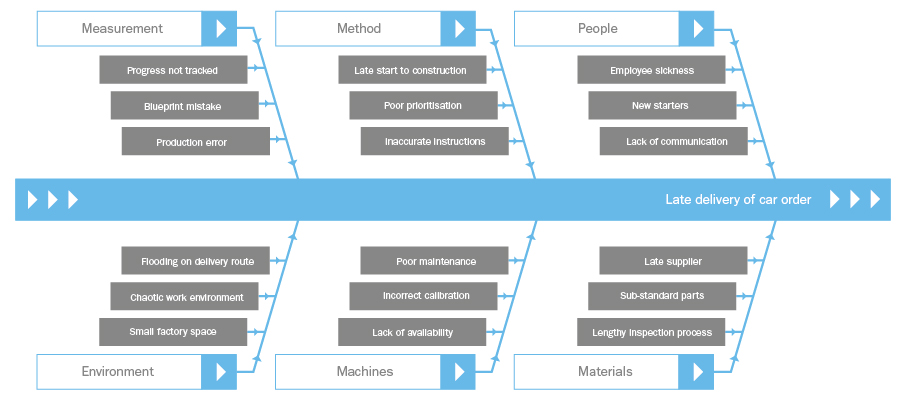
You may also like to walk through your business’ processes to discover the exact location of the root cause. In this case, a process flow diagram may be useful. This is essentially a flowchart that illustrates the relationship between major components.
5D: Permanent correction
Once you are happy that you have found the root cause of your issue, it is time to put together a permanent corrective action. This action will replace the temporary measures you put in place.
In the case of the factory water spillage, the permanent corrective action will be to create a new maintenance schedule to prevent excessive damage.
When you have a plan of what to do, you need to establish its probable effectiveness before you put it into action. Simulations or tools such as Accelerated Life Testing (ALT) can be handy for this. ALT is useful in manufacturing as it tests a product by subjecting it to extreme conditions. Once you’re satisfied that you have found the right solution, it’s time to move to the next stage.
6D: Implementation
It’s now time to implement your chosen permanent corrective action.
To implement it correctly, you need to create a project plan that covers communication to the relevant work teams and overseers as well as the steps to completion. Make sure you also decide how you will measure your success.
7D: Prevention
This stage is dedicated to making sure you prevent the non-conformity from reoccurring.
For example, in the case of the water spillage from the pipeline, the preventative action will be to communicate the new maintenance checks to the relevant team and to issue training on how to check the pipes.
Sharing your knowledge and the lessons learned during the fact-finding process is also key. Make sure the problem and its resolution are communicated to the rest of the business and update documents and your ISO processes.
You may also like to take a look at related products or procedures to see if similar problems are occurring in different parts of the business.
8D: Feedback
The last discipline is dedicated to rewarding your problem-solving team and recognising their efforts. Feed back on their performance and highlight any areas for improvement – this will help them to develop their problem-solving skills and tighten up the process during the next investigation. Once that’s done, it’s time to celebrate!
Need some extra support?
Running a management system and playing detective when it comes to non-conformities can be quite challenging when you’re juggling other business needs.
For more support or guidance, you can reach our team of experts by calling 0333 344 3646 or emailing [email protected] .
Sign up to get the latest in your inbox
- Email address
About the author
Claire Price
Content Marketing Executive
Claire worked for Citation ISO Certification between 2020 and 2022 writing creative and informative content on ISO certification and consultation to help businesses reach their potential.

Looking for some guidance? Join us for one of our upcoming seminars!
QMS International use cookies to provide you with a better site experience, enable features and to help us understand how our website is being used.
By continuing, you consent to the use of cookies in accordance with our Cookie Policy
Allow All Cookies
Allow Strictly Necessary Cookies Only
Please Wait...

IMAGES
VIDEO
COMMENTS
The eight disciplines (8D) model is a problem solving approach typically employed by quality engineers or other professionals, and is most commonly used by the automotive industry but has also been successfully applied in healthcare, retail, finance, government, and manufacturing. The purpose of the 8D methodology is to identify, correct, and ...
Eight Disciplines Methodology ( 8D) is a method or model developed at Ford Motor Company used to approach and to resolve problems, typically employed by quality engineers or other professionals. Focused on product and process improvement, its purpose is to identify, correct, and eliminate recurring problems. [1]
The 8D problem solving process is a detailed, team oriented approach to solving critical problems in the production process. The goals of this method are to find the root cause of a problem, develop containment actions to protect customers and take corrective action to prevent similar problems in the future. The strength of the 8D process lies ...
The 8D problem-solving method is designed to address and resolve problems by identifying, correcting, and eliminating recurring issues. It involves eight different steps: Plan — Prepare for the problem-solving process. Team selection — Assemble a team with the necessary knowledge and skills. Problem definition — Clearly define the problem ...
The 8D Problem Solving process provides a reliable and systematic method that ensures that the problems inside a company or project are solved by eliminating their root causes and preventing recurrence. However, it is most suitable for complex problems that can take weeks or even months to solve. Therefore, the first stage aims to determine if ...
8D (or Eight Disciplines of Problem Solving) is a methodology for solving problems that aims to identify the root cause of the problem and provide a solution. 8D is a great first step in improving quality and reliability. Ford Motor Company created this problem-solving method, which was then called Team Oriented Problem Solving.
The 8D Problem-Solving methodology was developed in the late 1980s by Ford Motor Company. The term "8D" stands for "Eight Disciplines," which represent the eight critical steps in problem-solving. Initially it was only intended to resolve issues within the automotive manufacturing process. However, over the year since then the ...
The eight disciplines (8D) method is a problem-solving approach that identifies, corrects, and eliminates recurring problems. By determining the root causes of a problem, managers can use this method to establish a permanent corrective action and prevent recurring issues. First introduced by Ford, the 8D method offers a consistent way of ...
The Ford Motor Company® developed the 8D (8 Disciplines) Problem Solving Process, and published it in their 1987 manual, "Team Oriented Problem Solving (TOPS)." In the mid-90s, Ford added an additional discipline, D0: Plan. The process is now Ford's global standard, and is called Global 8D. Ford created the 8D Process to help teams deal with ...
The 8D approach to problem-solving, also known as the 8D methodology, is a systematic and comprehensive method used to address and resolve complex issues, particularly in manufacturing and other industries. This 8D troubleshooting methodology involves a structured process designed to identify, correct, and prevent issues, ensuring that similar ...
The 8D Problem Solving methodology is commonly known as "Eight Disciplines of Problem Solving" or simply "8D." It is a structured, team-based approach to identifying, analyzing, and resolving problems, particularly in the areas of product quality and process efficiency.
Eight Disciplines (8D) is a problem-solving methodology designed to address, correct, and eliminate recurring problems impacting business operations, manufacturing, and product development. Developed by Ford Motor Company in the 1980s, the 8D method has since been widely adopted across various industries as a comprehensive quality and process ...
Effective problem solving can help mitigate risks, focus teams and improve processes. The eight disciplines (8D) are a systematic, team-based method of problem-solving that seeks to determine the underlying reasons for the problem and to fix reoccurring issues. Learning the eight disciplines problem-solving process can help you discover ...
The purpose of 8D problem solving method is to identify, correct and prevent problems affecting customers and operational efficiency. It is a problem solving approach similar to PDCA cycle (Plan - Do - Check - Act). 8D stands for 8 Disciplines. It is a methodology that emphasizes "No problem should be repeated but fixed permanently".
What is 8D problem-solving? 8D problem-solving is an approach that quality engineers and manufacturers use to identify and address challenges throughout a project. 8D refers to the eight different disciplines, or steps, that the process entails. Note that since its inception, the 8D problem-solving method has added a stage for planning at the ...
The eight disciplines for process improvement or problem-solving are as follows: 8D Step - D1: Establish the Team. Identify team leader and team members. Establish a team of competent people with product/process knowledge. Cross-functional team-CFT members must be related to the concerned problem. Identify the team's goals and objectives ...
History of 8D Problem Solving Process. There was a dire need for a team-oriented problem-solving strategy based on the use of statistical methods of data analysis. Ford Motors during World War II were manufacturing war vehicles in bulk. To ease up the assembly lines and the entire management in general, the executives of Powertrain Organization ...
The 8D (8D Problem-Solving Method) method, also known as 8 disciplines, first appeared in Ford's 1987 "Team-Oriented Problem Solving" manual.It is a tool that has stood the test of time and has become the first solution used by the company known today as Global 8D. Although the 8D method has been around for years, many companies still face the problem of low resolution and poor use of fixes.
The 8D problem-solving method is a comprehensive, qualitative and collaborative practice that professionals use to recognise, fix and eliminate recurring problems. It is a systematic procedure that involves improving business processes and operational efficiency. This method uses a team-based approach that focuses on eight distinct stages to ...
the following are the 8 basic steps of the 8-d process: 1. team contact initiator • reference information about the and assignee of the 8-d. 2. describe the problem • statement description of the actual concern (problem). also, the source that it came from and severity, or, how bad it is. 3.
8D is a disciplined process which addresses problem solving in a methodical and analytical way. Each step of the 8D analysis Process is preceded by letter 'D' which stands for discipline. The 8D process seeks to define and understand a problem, so that by taking this approach we can continuously improve quality by eliminating the causes of ...
The 8D problem solving process is team structured, consisting of 8 steps (the '8 disciplines'). It is a methodology to find the root cause of a problem, put in an interim fix while a deeper investigation is carried out, and then put in place a permanent solution that prevents the problem from being repeated.
The 8D method was originally the brainchild of the Ford Motor Company. The concept was developed in the 1980s and was initially given the moniker TOPS (Team Oriented Problem Solving) due to its emphasis on a team approach. This approach proved to be incredibly effective, and the process has now been adopted by other companies to root out their ...
Title: Five Steps of Problem Solving Author: Centers for Disease Control and Prevention Keywords: problem solving Created Date: 8/1/2024 6:48:36 PM